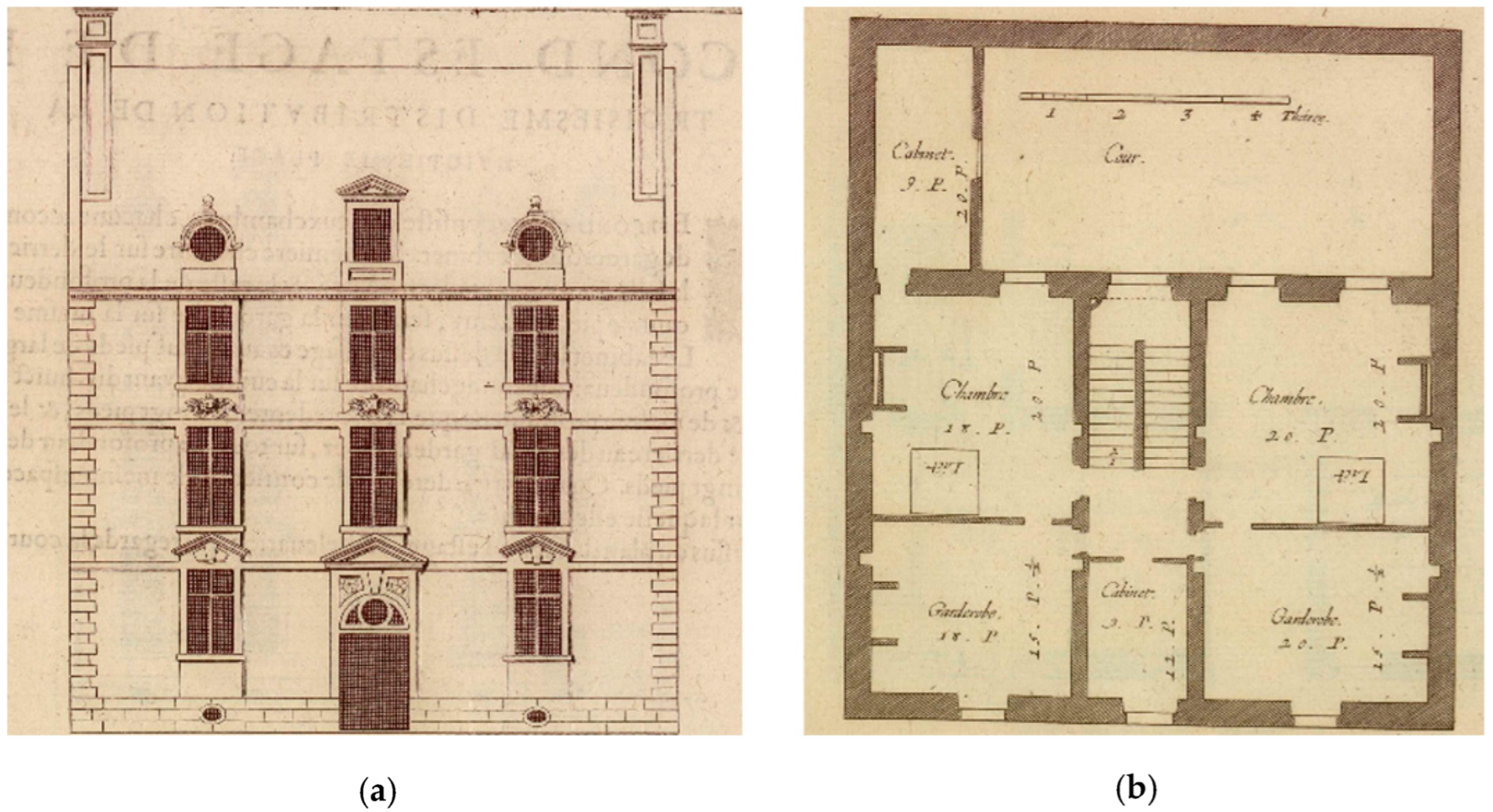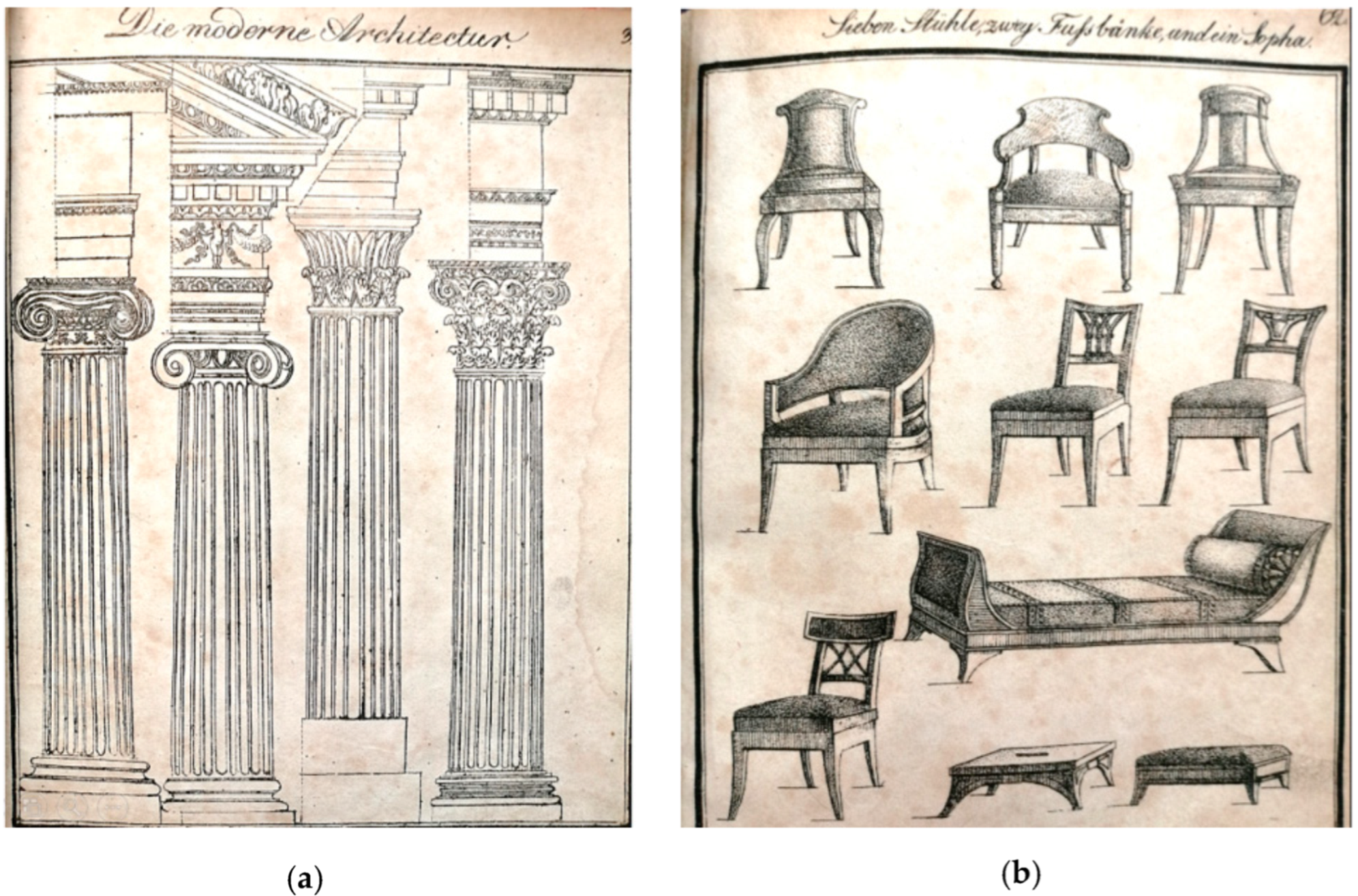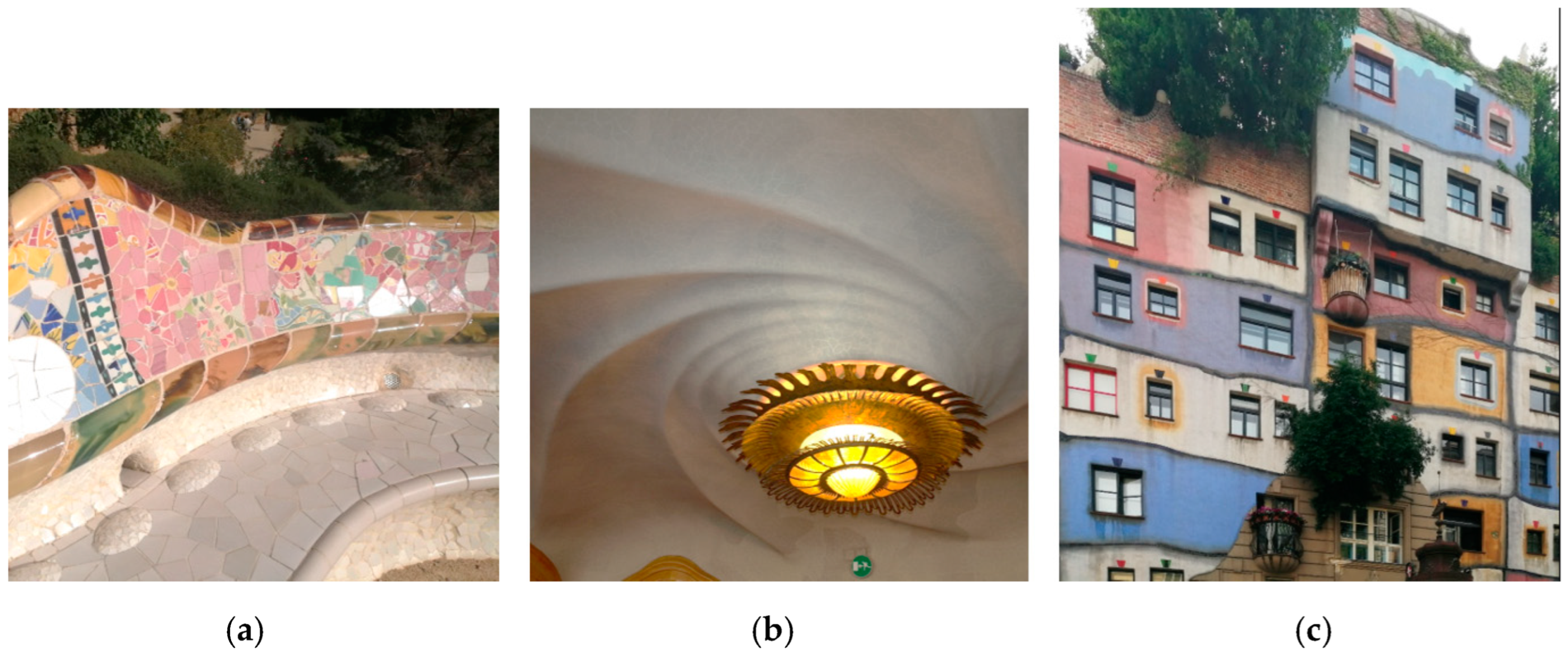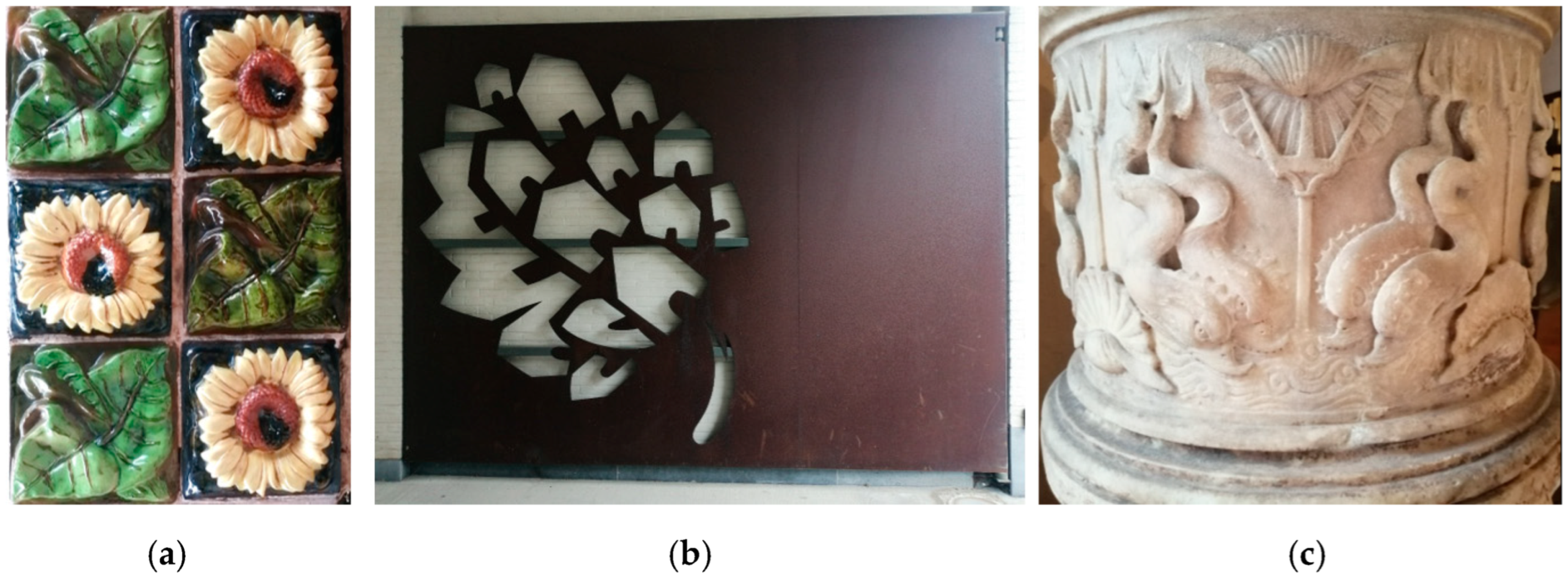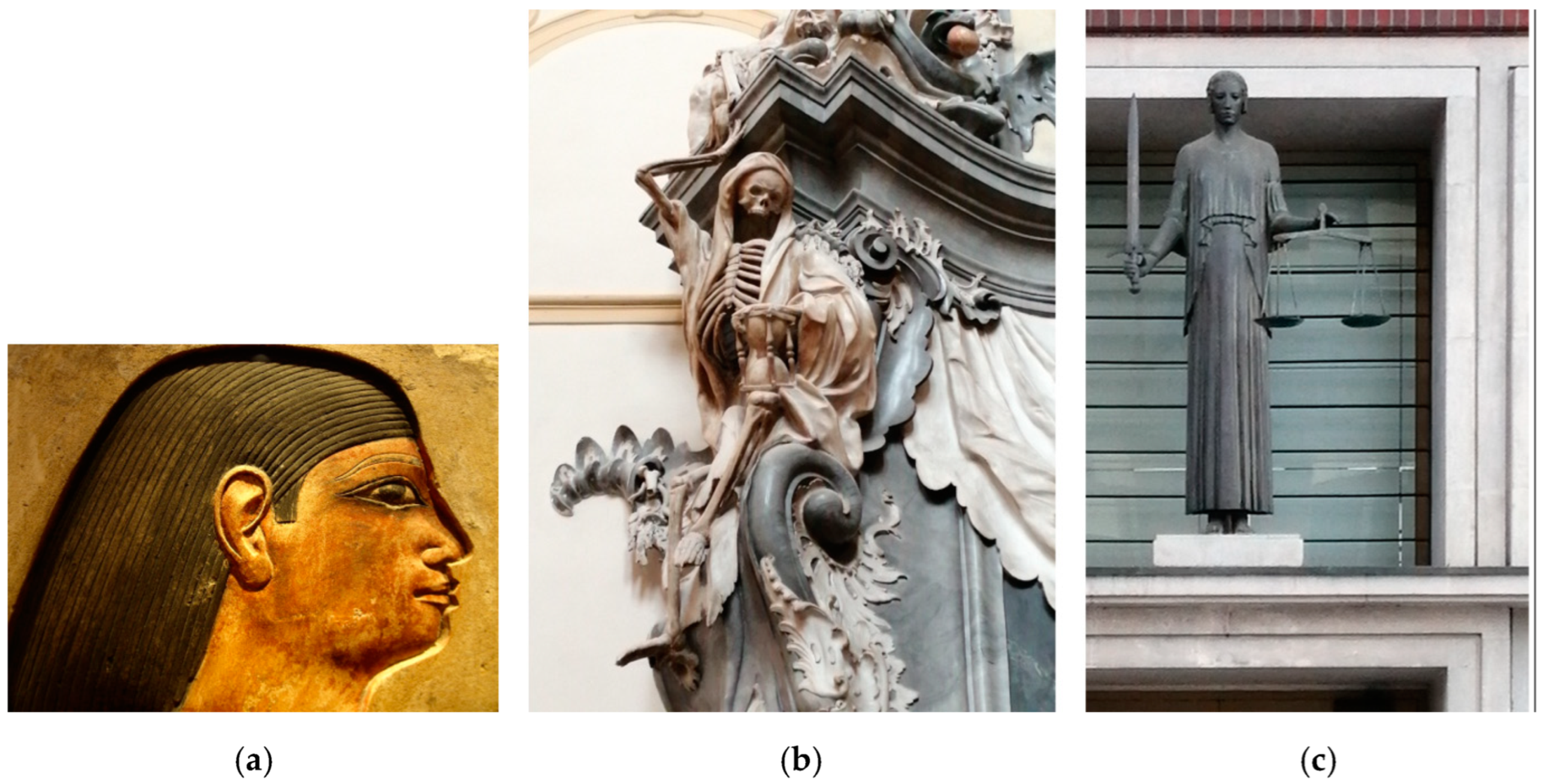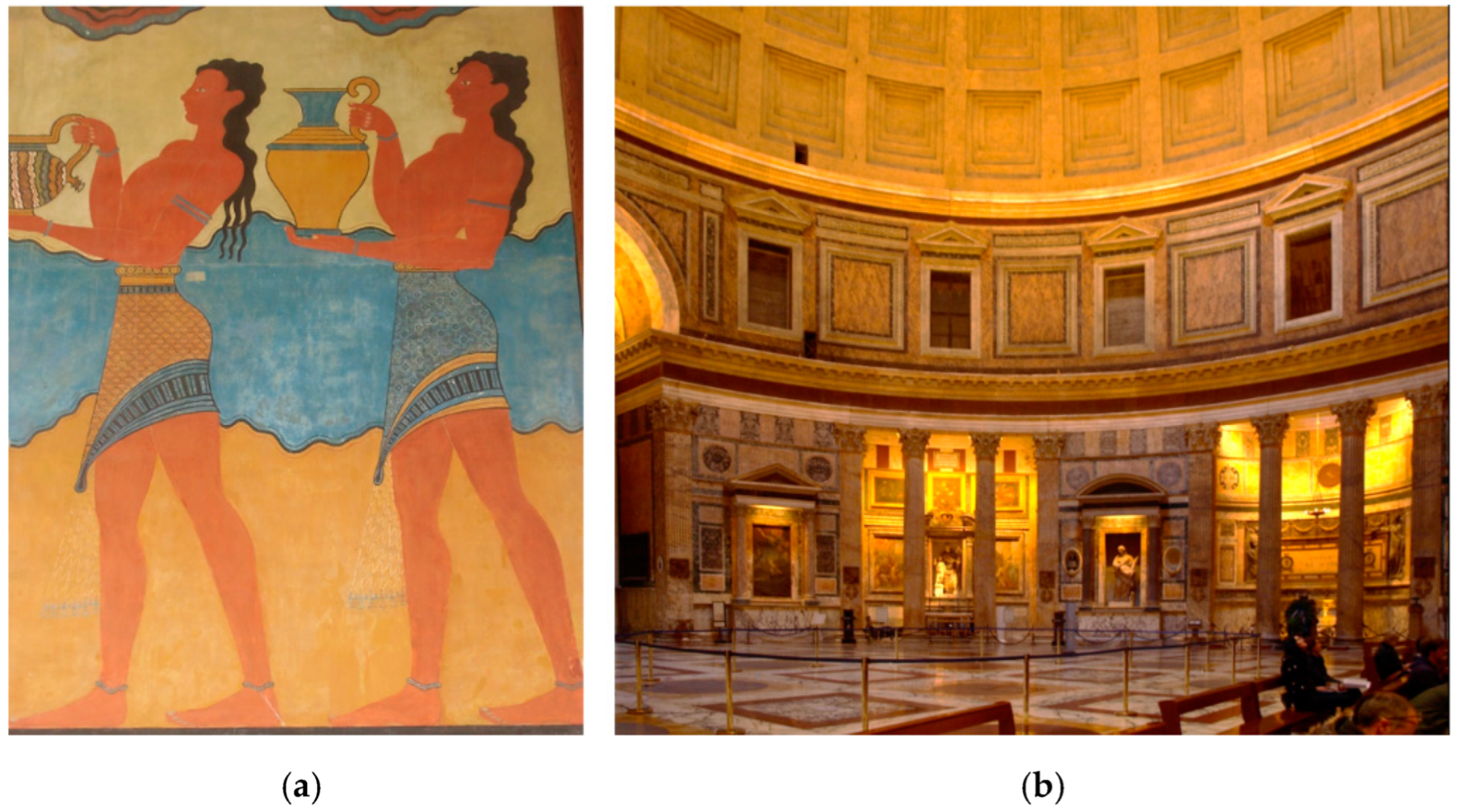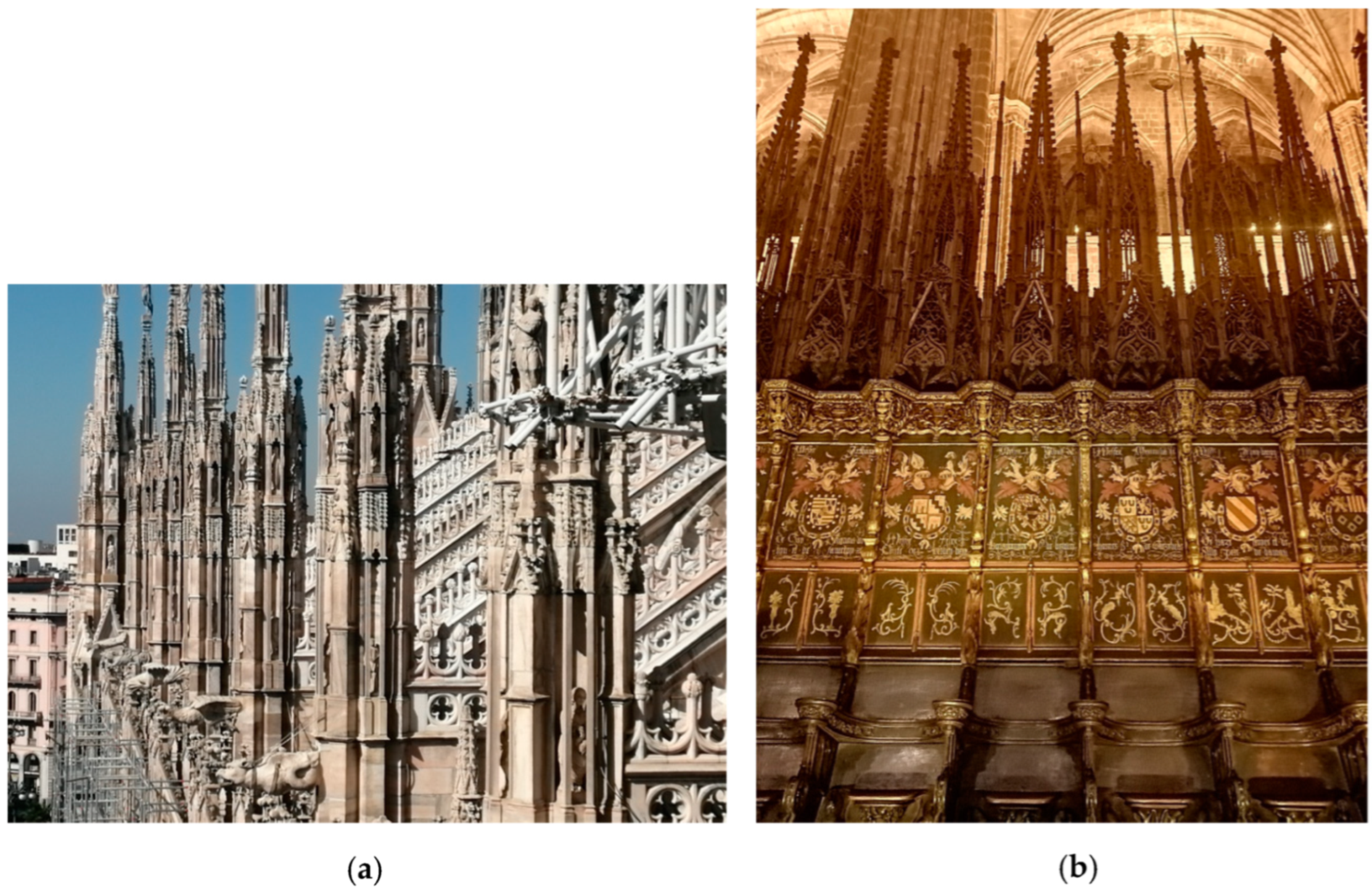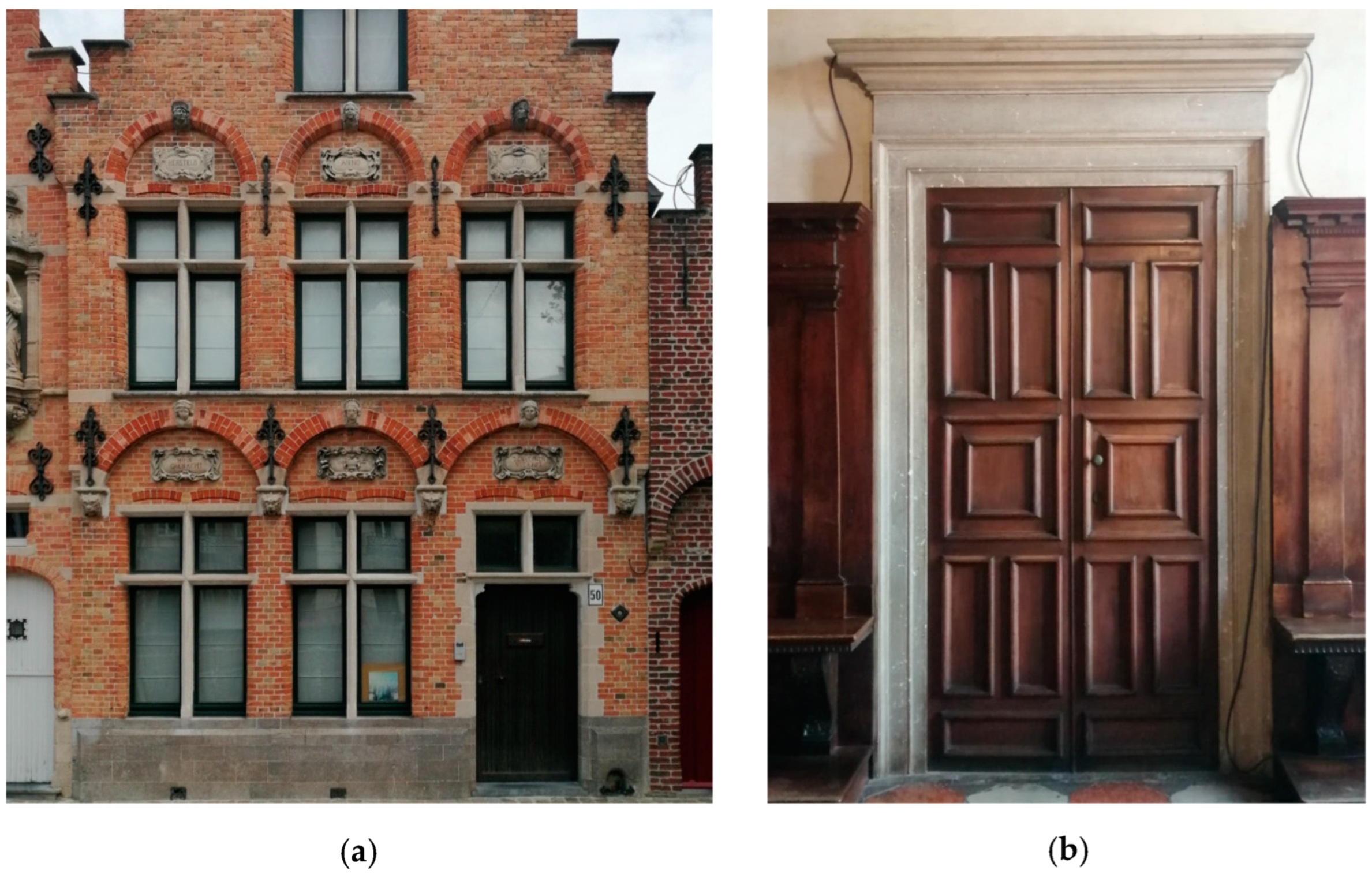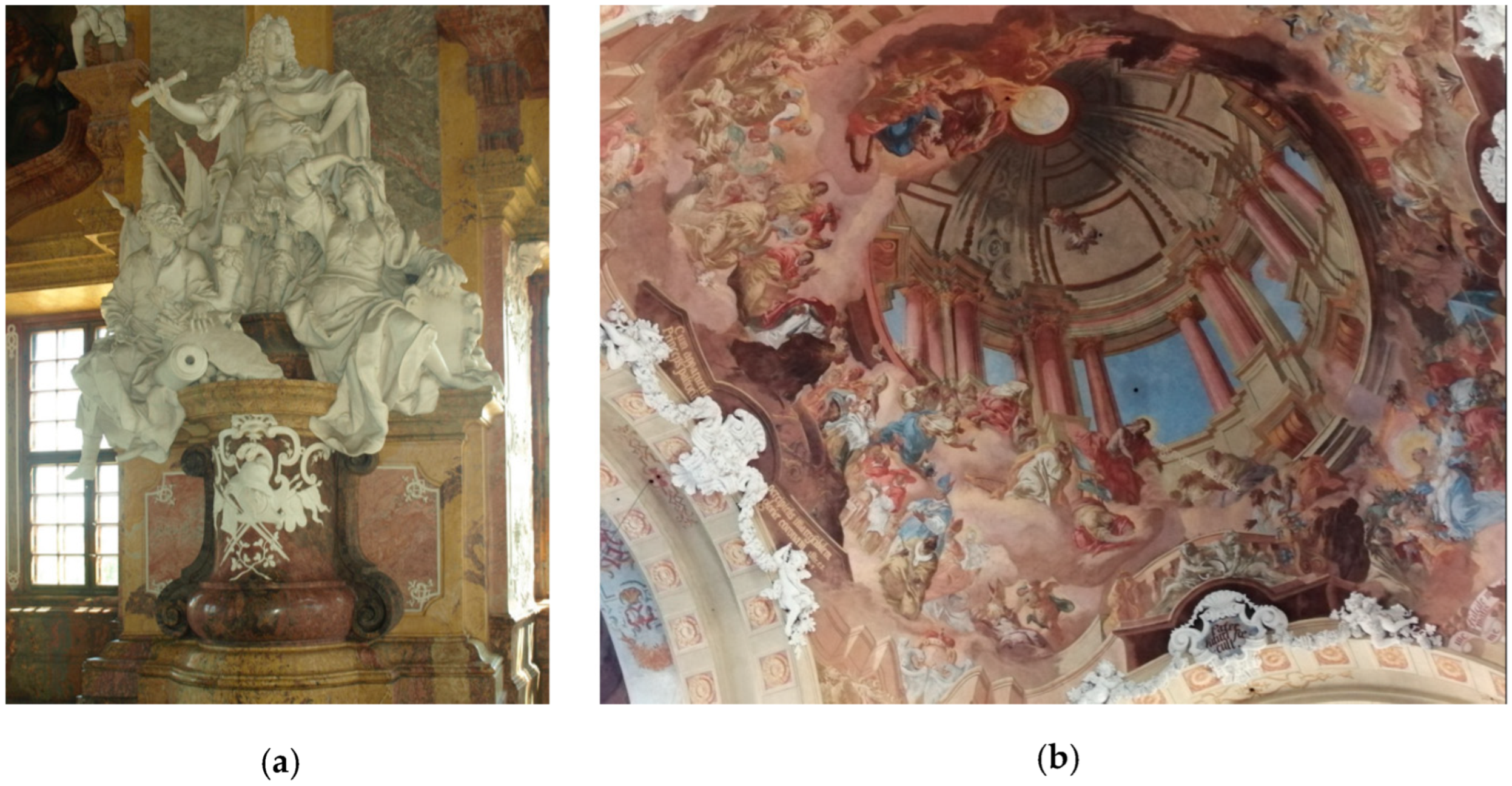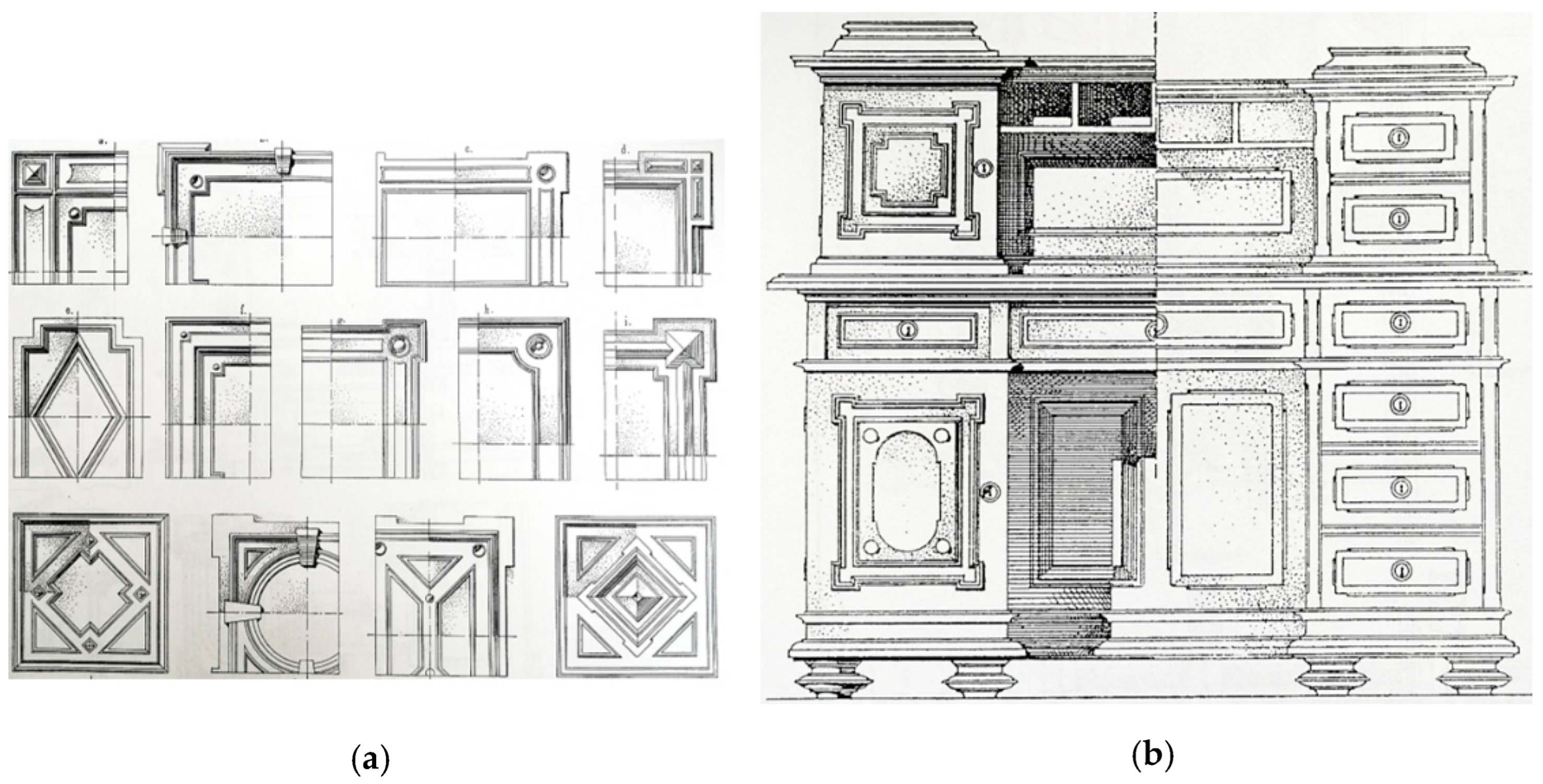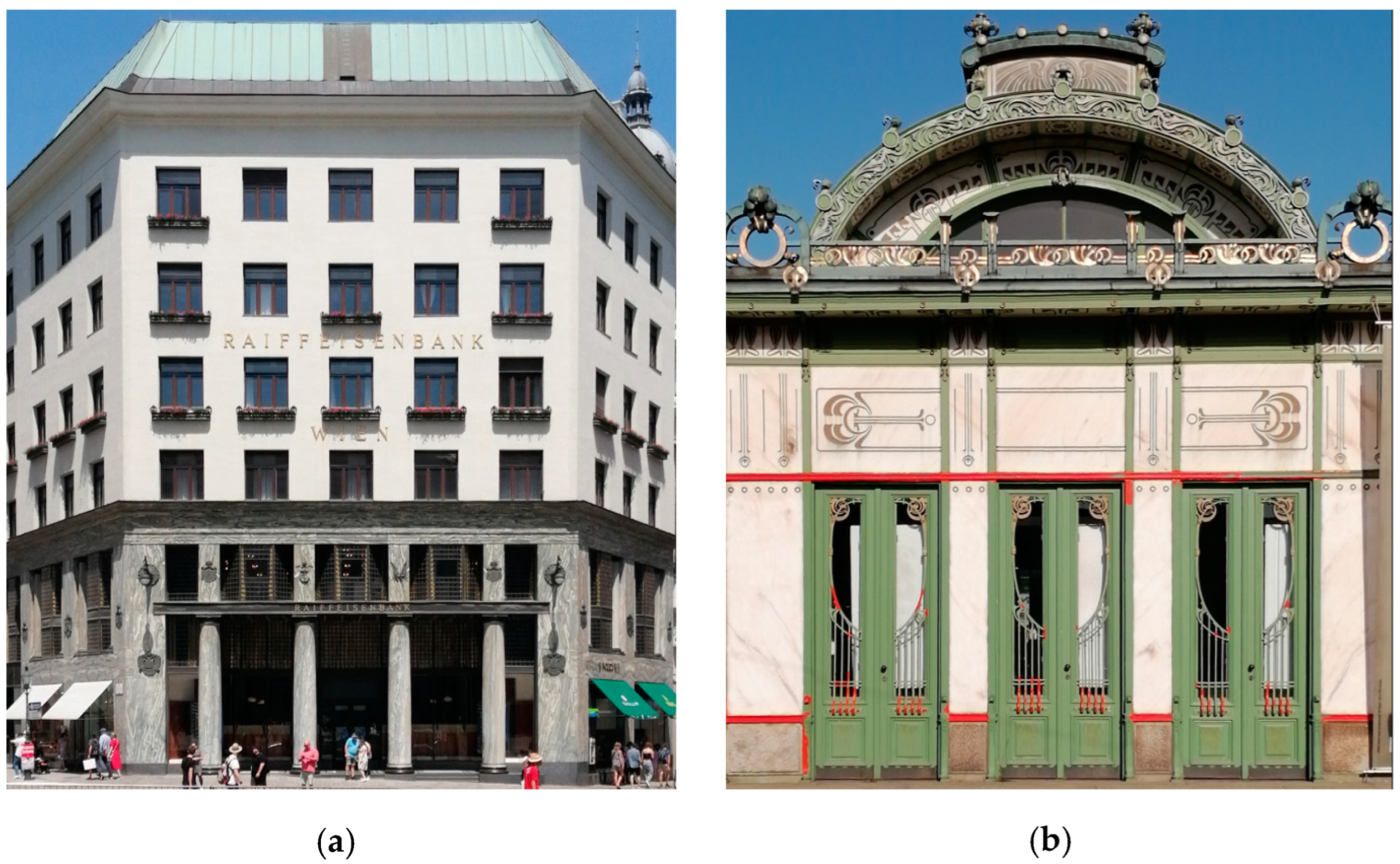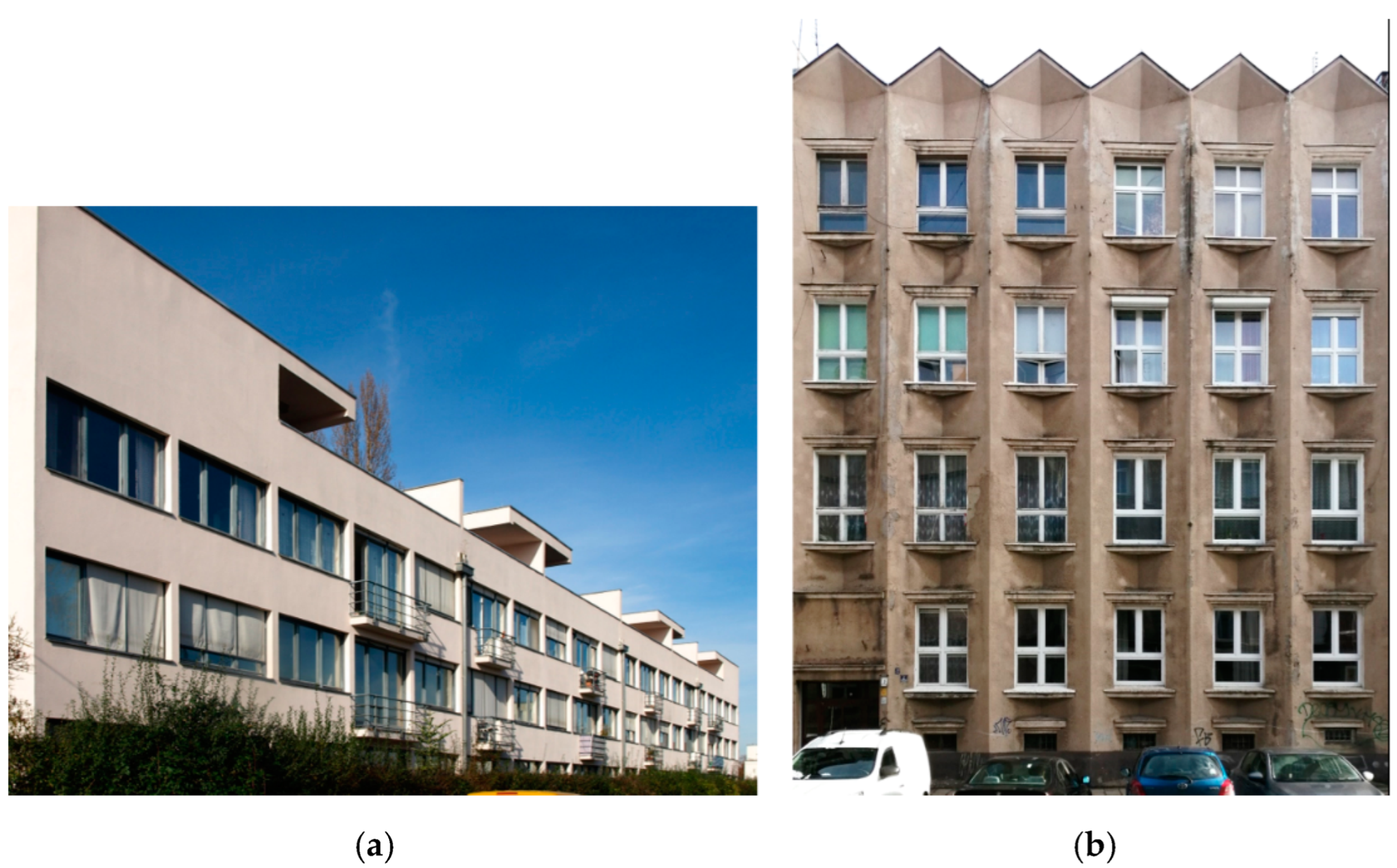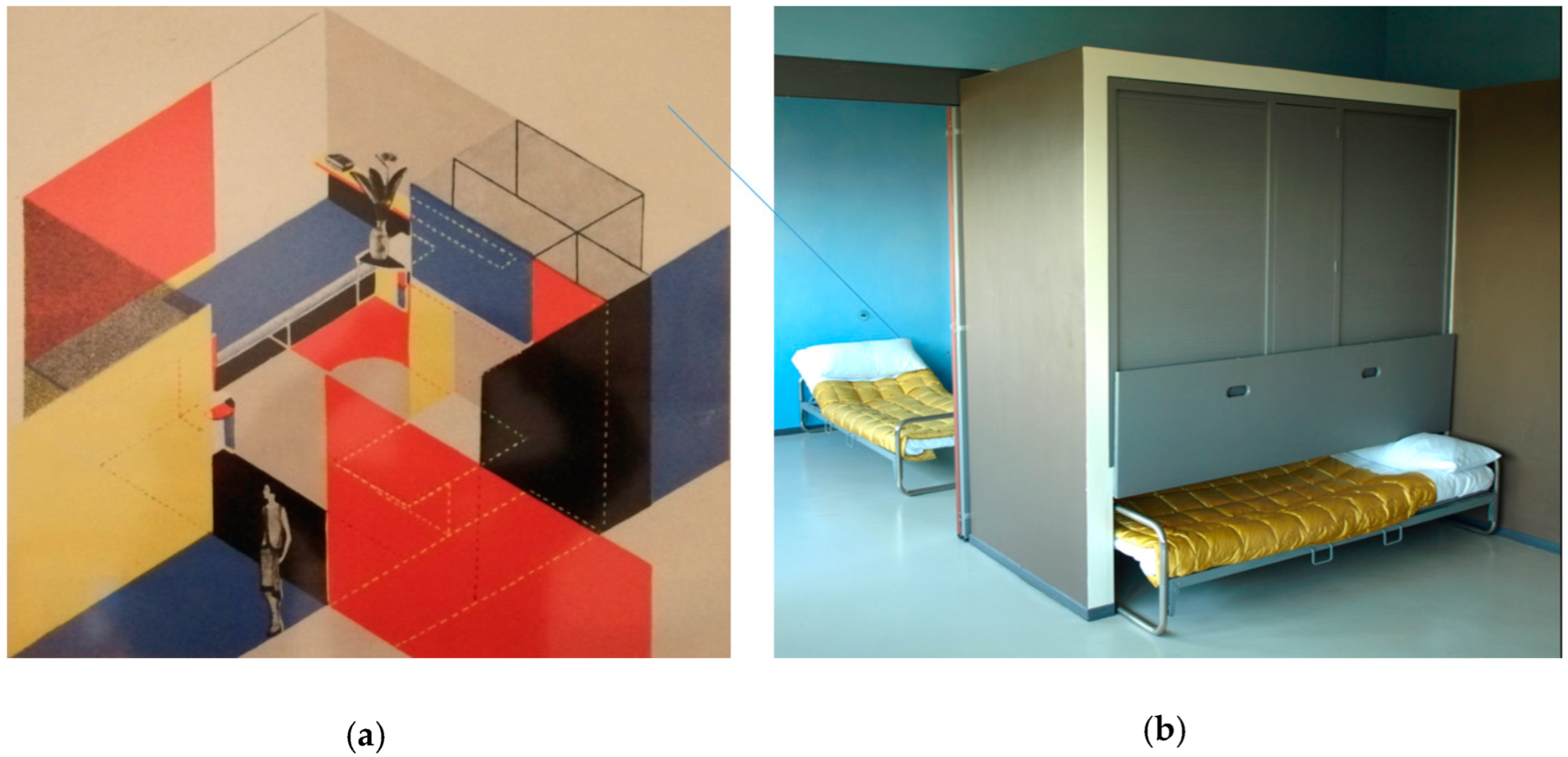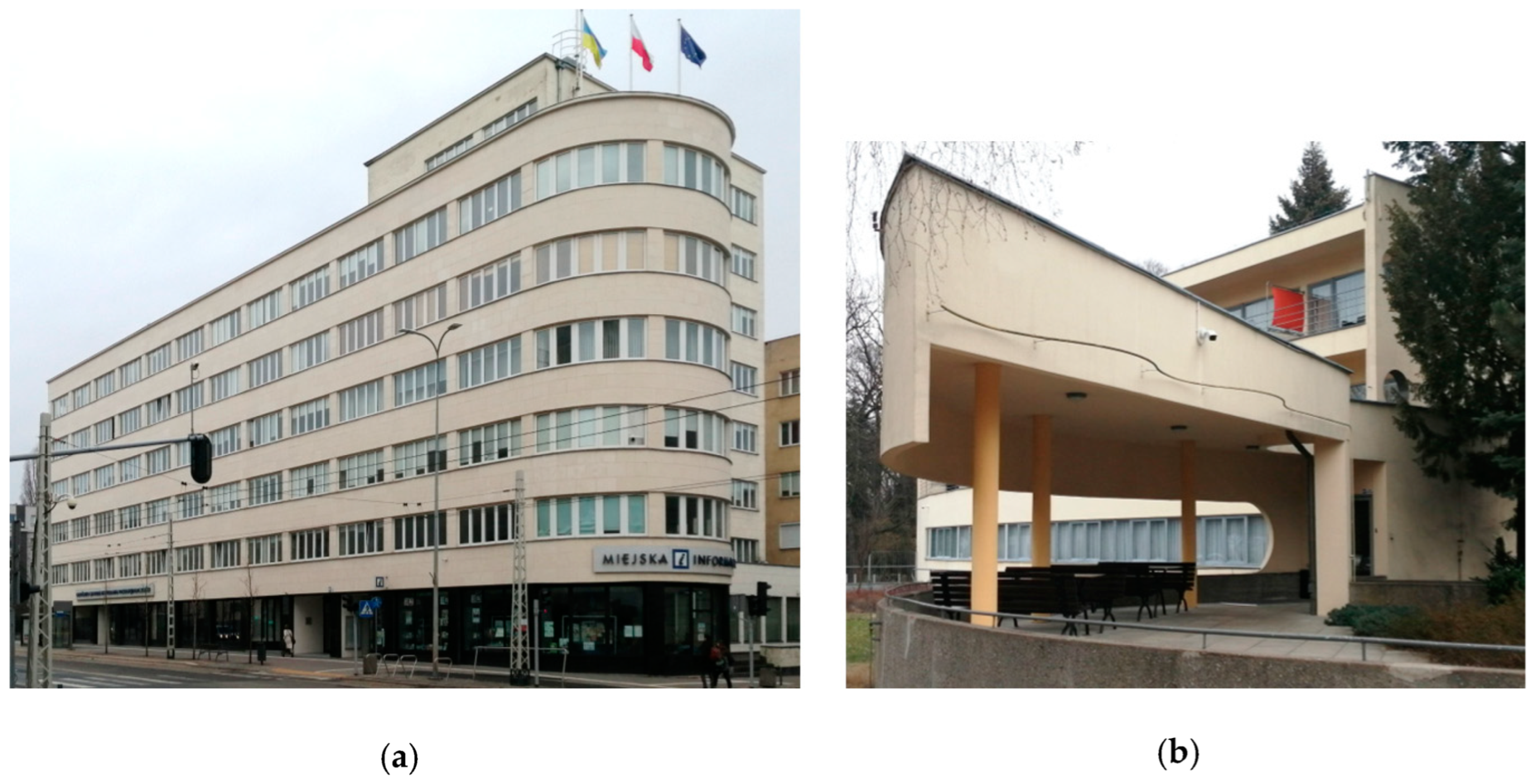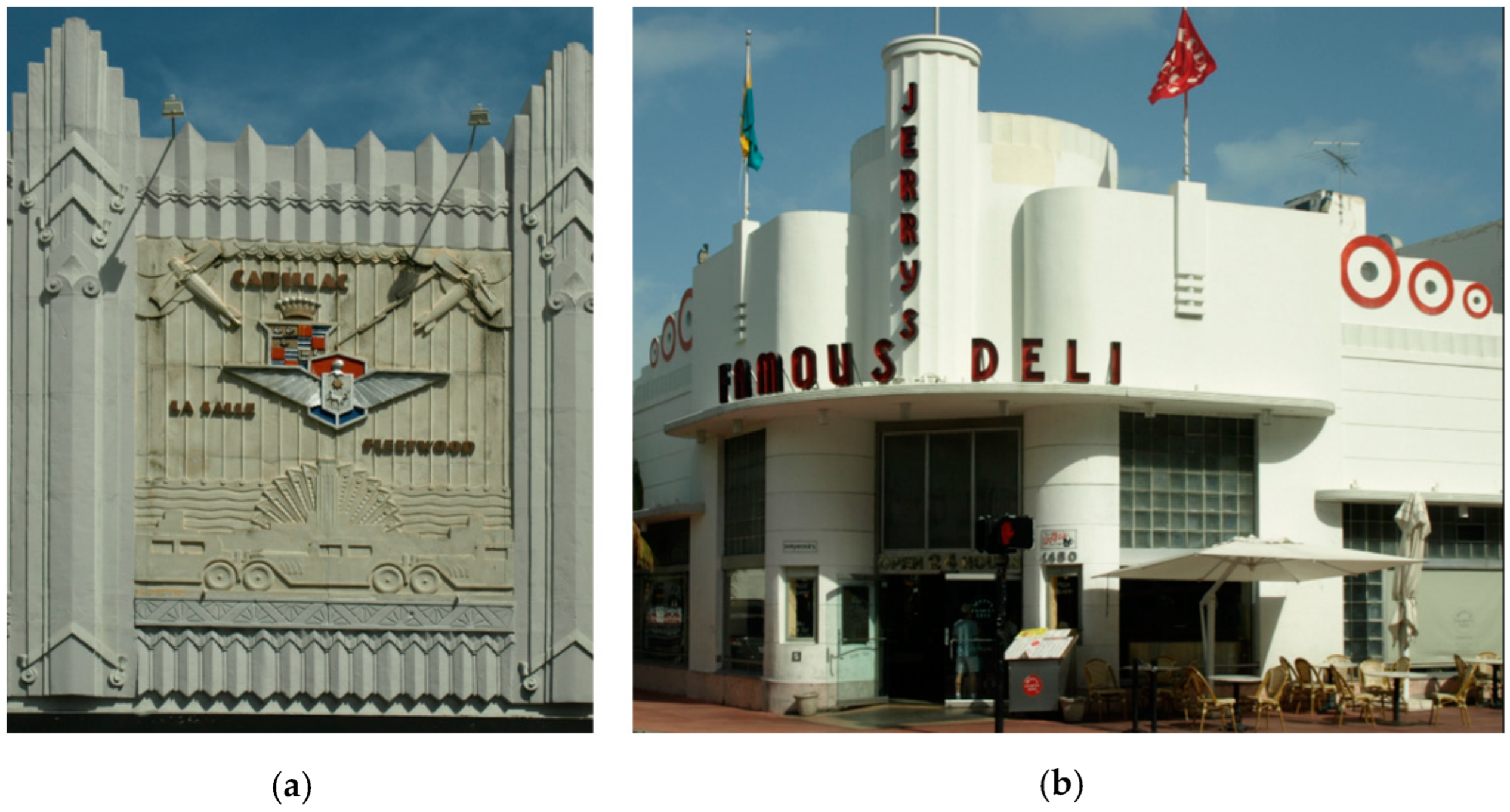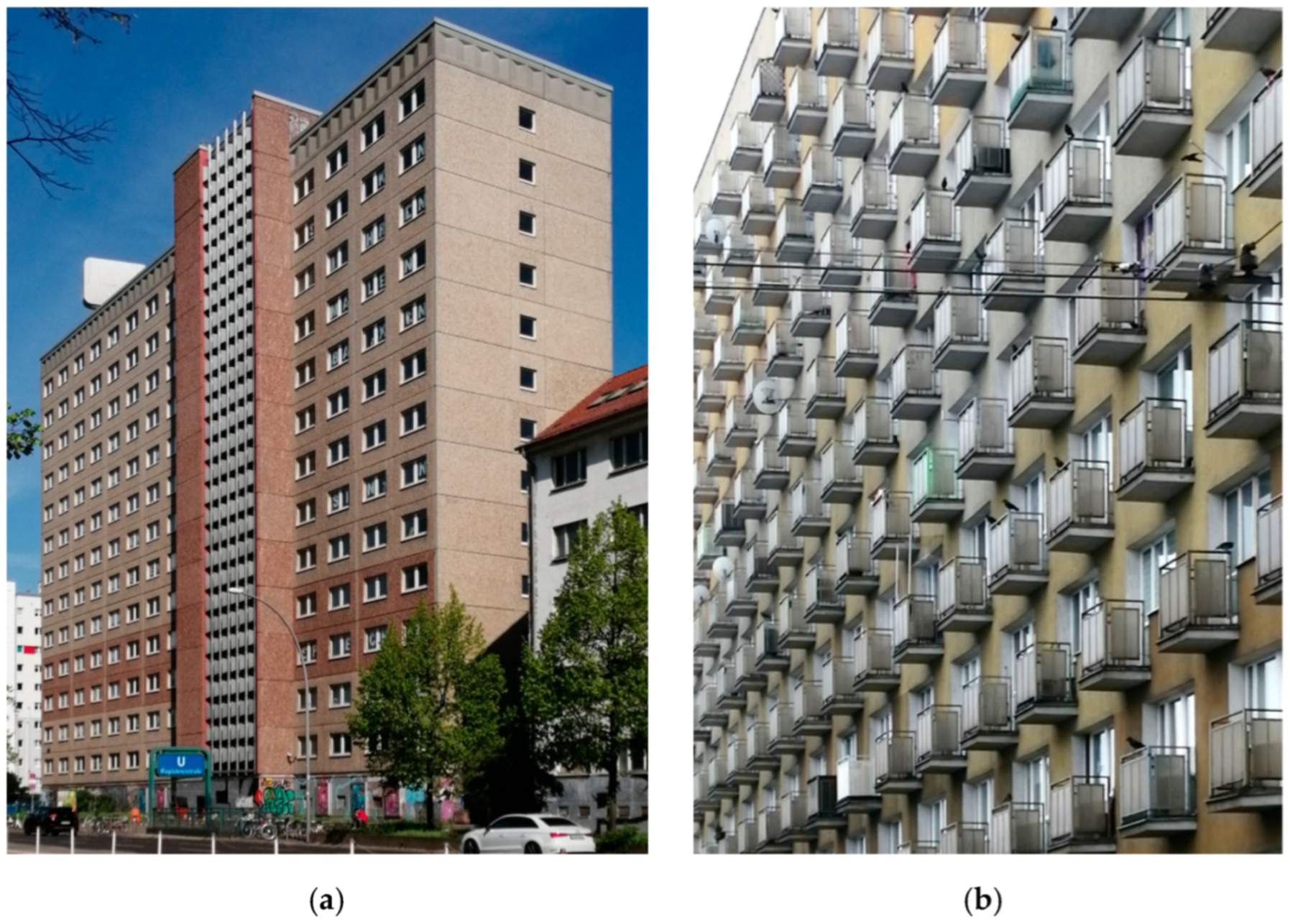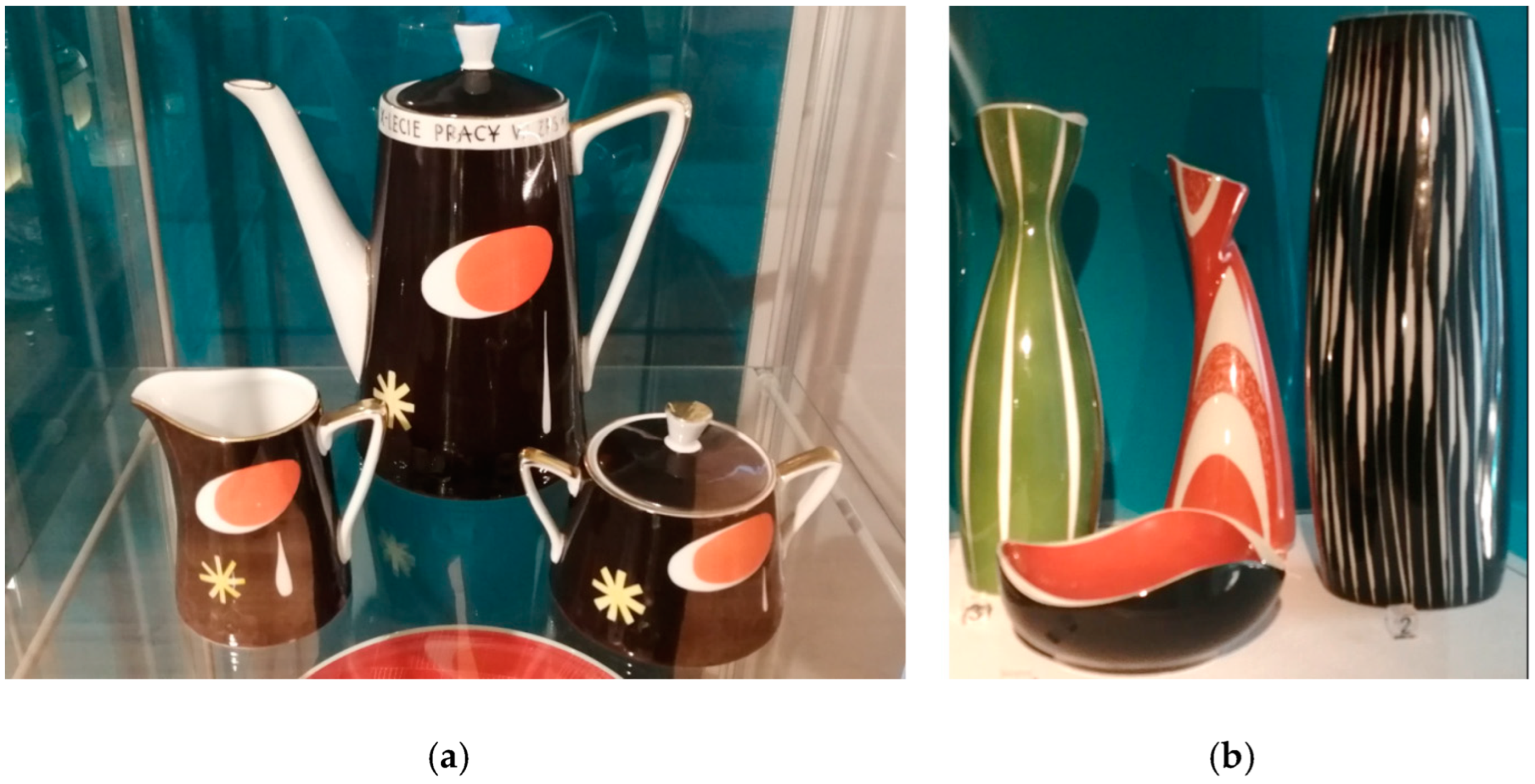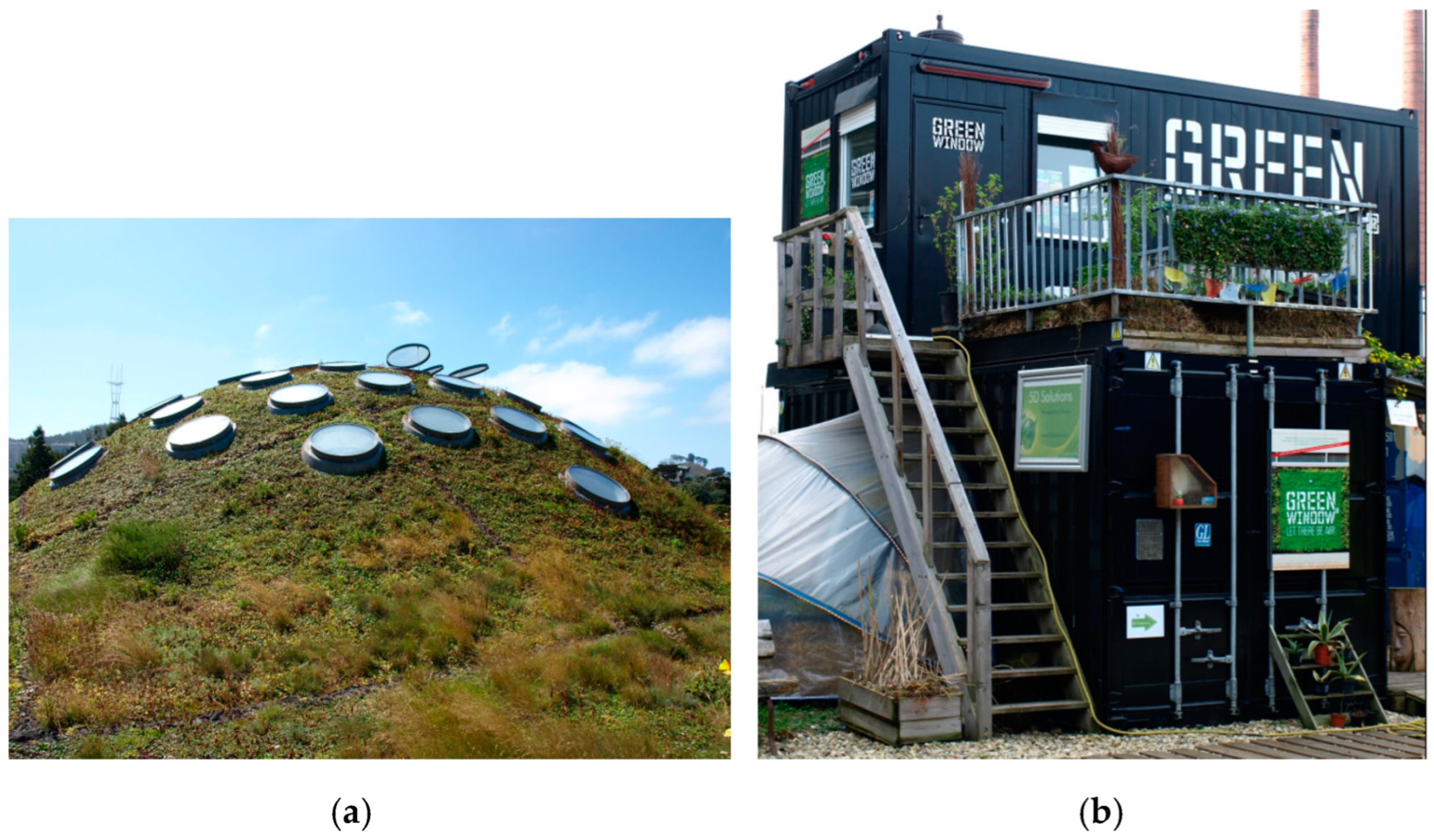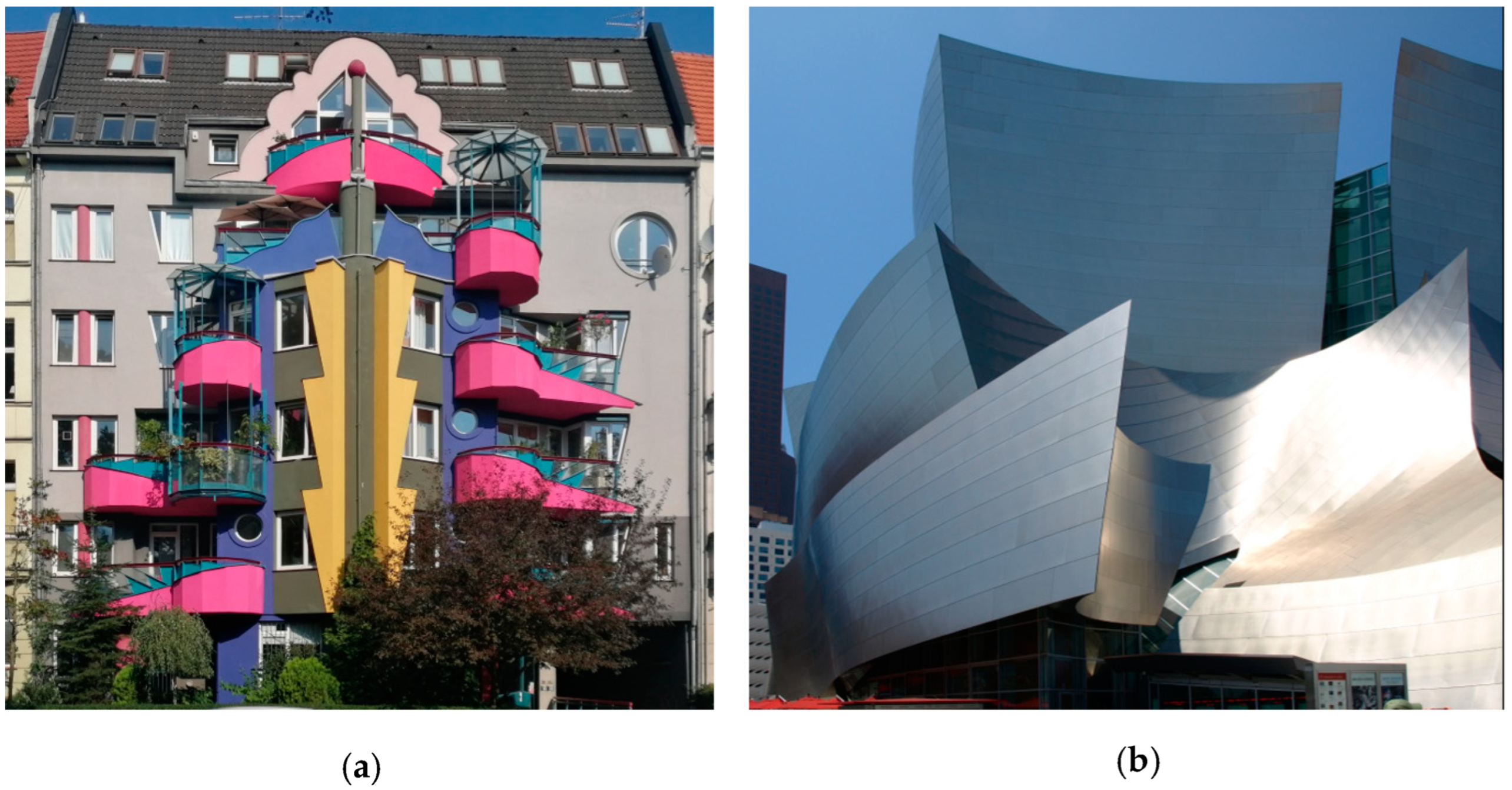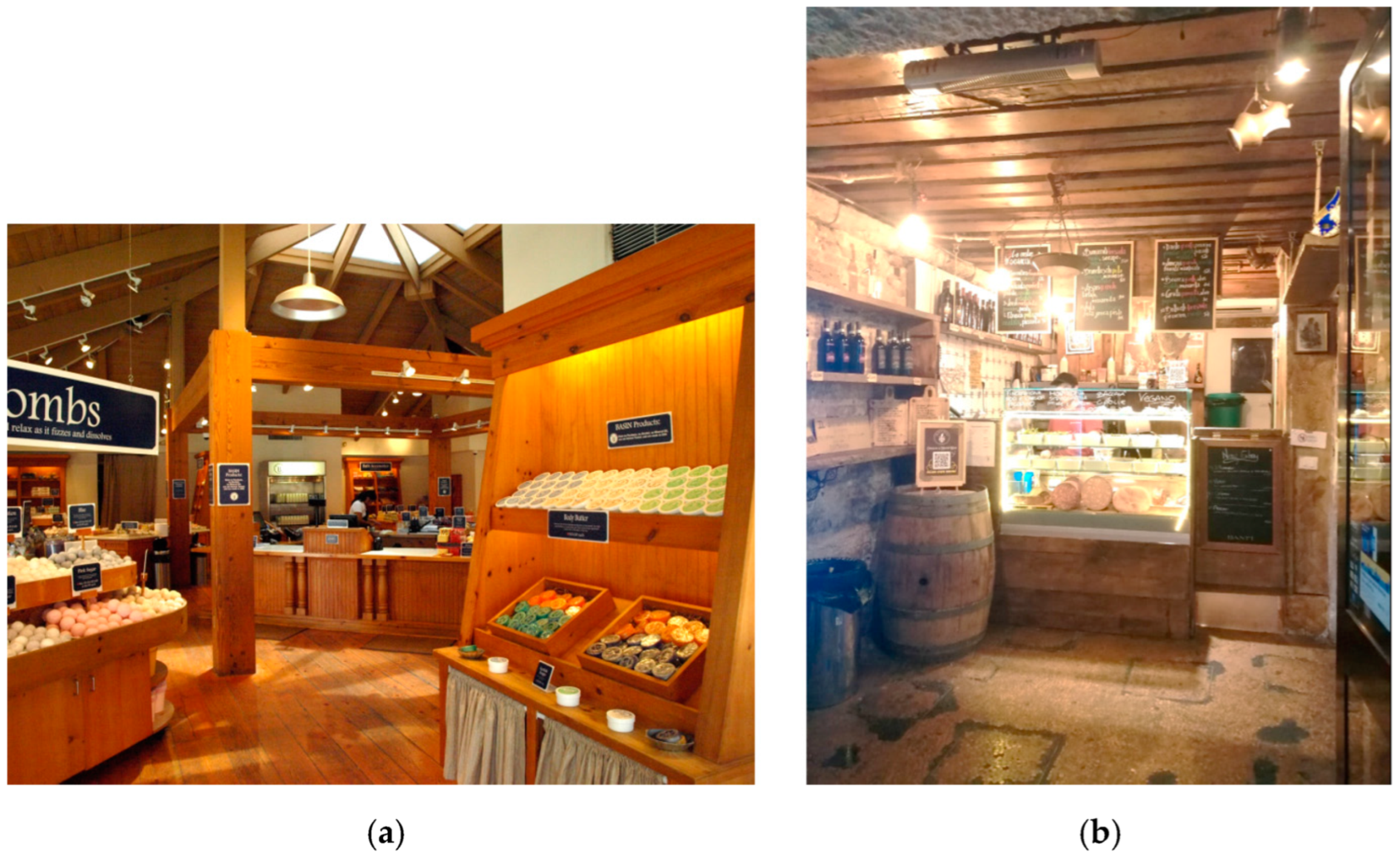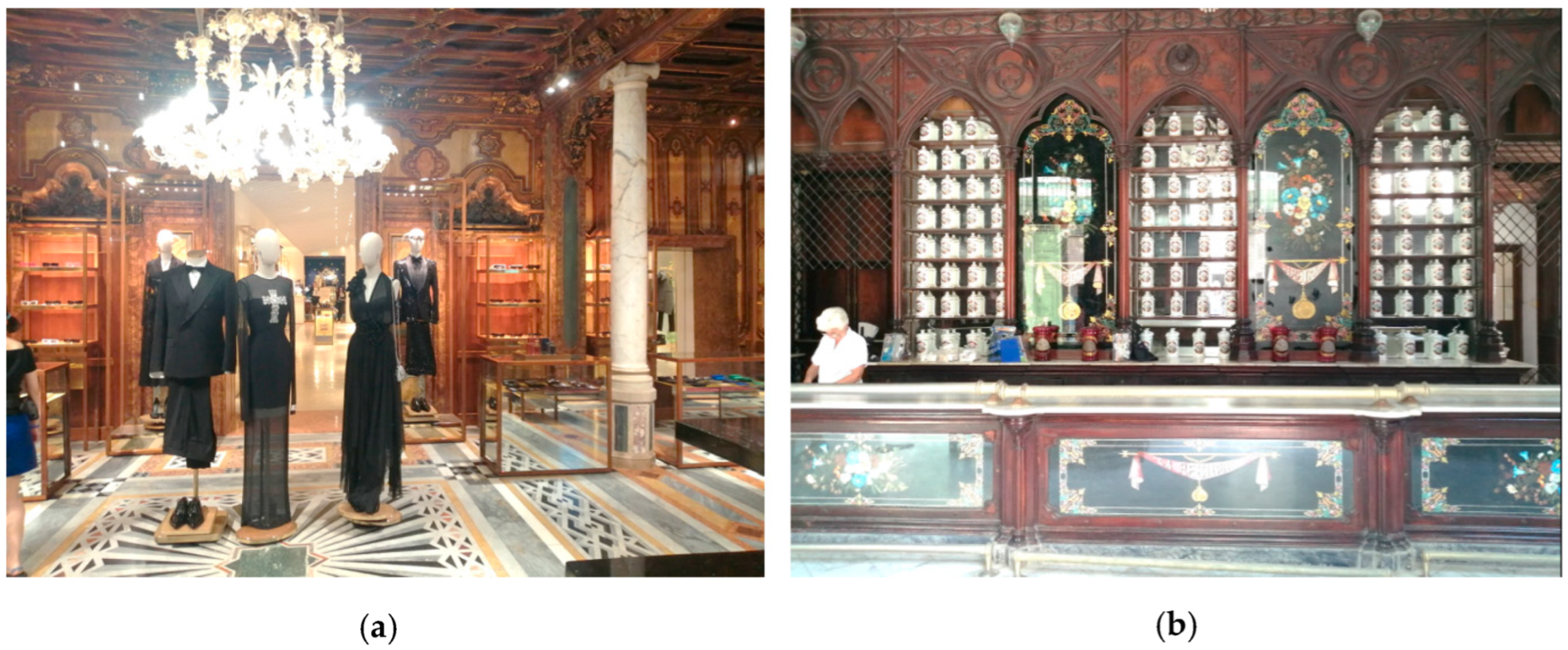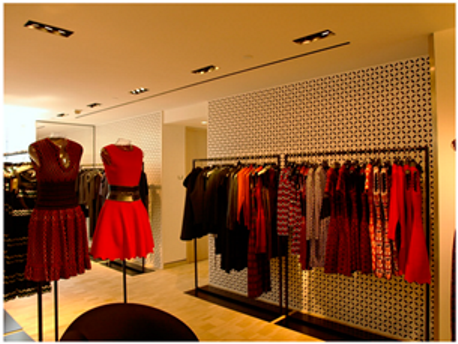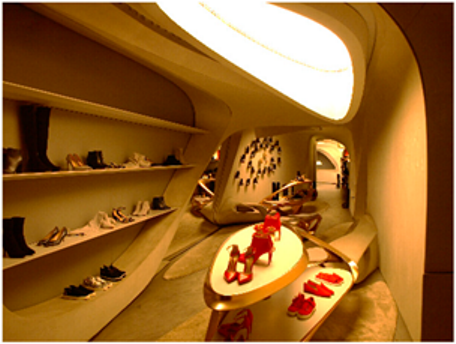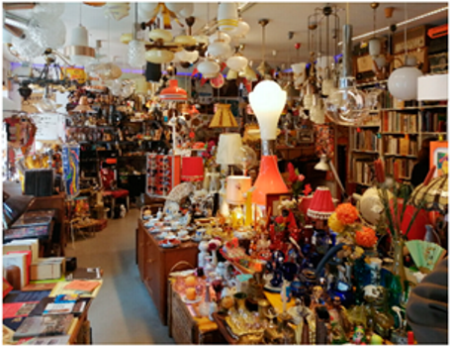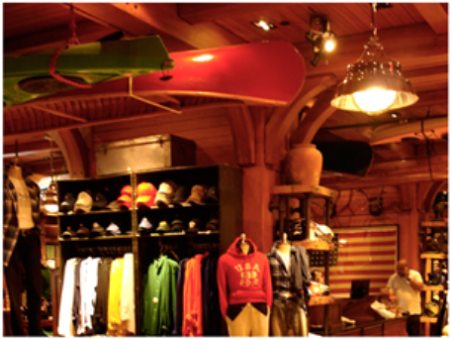1. Introduction
Beauty is a property of creation that evokes positive feelings. It is identified with a psychological reaction to specific features, mainly visual ones. It results from maintaining proportions, harmony in space, colors and sounds [
1]. Features of the natural environment, the world of plants and animals, are associated with it. This scope also includes human creative activity. It concerns the shaping of the built environment on an urban scale, architecture, interiors, and everyday objects. Activities that meet higher-level needs, less related to everyday life, also include works of “fine arts”: literature, music, painting, sculpture, as well as philosophy and other sciences.
Beauty in the built environment is related to the positive atmosphere and aesthetic perception of a space by people who emotionally observe the surroundings. Many landscapes, cities, and buildings are widely recognized as extremely beautiful. They are often the destination of tourists from other regions of a country or abroad. They are particularly valuable aesthetically, socially, and economically, especially for their communities.
In various periods, specific styles were preferred and used in newly constructed buildings and their interiors. Changes in style depended on technical progress, which influenced building techniques. Social conditions, including economic and even religious ones, were also of great importance. Subsequent industrial revolutions and related new production techniques have made it possible to create shapes and forms previously unseen in nature and in the artificial environment of human life. These changes occur along with a better understanding of the world on a micro- and macroscale. The development of consumerism is accompanied by the need for newer and newer goods, accompanied by high pace and economics of production, access to raw materials, and the method of their processing.
In the field of architectural design and applied art, beauty is currently associated with the purpose of a product, moderation in the use of forms, and utility. These features are combined with the technique of production. Moderation of forms is a more subjective concept. It can be viewed in a historical context, taking into account technological developments, social processes, and individual and collective tastes (fashion). In turn, the utility of an object is supposed to benefit a person in the sphere of meeting his basic and higher-level needs. The products are then positively evaluated and accepted by the general public. Users mainly expect high functional values, and designers also strive to achieve aesthetic perfection.
Today, beauty is perceived in the context of the phenomena of the surrounding world. It is determined by machines and large urban environments. The last century has shown dynamic changes in aesthetic trends in architecture, design, and various fields of art. It is difficult to indicate a clear ideal of beauty. It is not expressed in the form of “pure art”. It is associated with the “utility” of products in the context of sustainable development, ecology, and social inclusion.
Individuals and larger social groups have a similar ability to perceive space. They can practically and emotionally evaluate the beauty and usefulness of places and express different opinions. Assessments are justified according to individual or collective moral, aesthetic, and cultural values. Architecture and interior design is all about combining positive experiences in visual perception of the surrounding space and a sense of satisfaction when using various products of human activity. The study of the feeling of beauty has long been studied by philosophers, artists and designers, art theorists and critics, and other scientists in the field such as psychology, sociology, social anthropology, etc.
Expanding knowledge about the role of beauty and usability in architecture is an original contribution of the paper to the development of research. The focus was mainly on buildings and interior designs. This is particularly important in the context of industrialized technologies and building standards and the supply of mass-produced goods. Rational design and the use of artificial living environments are expressions of concern for the Earth’s natural resources (sustainable environment). This is facilitated by the design of beautiful, functional, and durable buildings and everyday objects. These issues are addressed, i.e., by an interdisciplinary initiative of the New European Bauhaus. The aesthetic and functional values of architecture can be universally assessed in the context of meeting the varied needs of users and protecting the natural environment. Various tools can be used in research, such as the innovative “Davos Baukultur Quality System” checklist. A modified fragment of the checklist was used for an exemplary assessment of the aesthetic and functional quality of several store interiors. This study may have broader, practical application in design and modernization work in the built environment.
The contemporary digital revolution is becoming a challenge for designers. The Davos checklist can have wide application and impact by disseminating its results in a virtual environment. The study of the beauty and utility of the immediate environment can be learnt even in remote areas and can be used by subsequent researchers and designers of the built environment and become part of the universal heritage.
The novelty of this article is the analysis of visual perception and the feeling of beauty, and the practical value of the usability of buildings and their interiors. The considerations are presented as an overview. They cover various eras of style. Past and contemporary architectural implementations constitute the material cultural heritage. Knowledge of them is the theoretical basis for conducting practical analyses and assessments of aesthetic and functional values in architecture. A universal tool for such assessments has been proposed. It takes into account the current needs of users and the natural environment.
3. Beauty and Utility in Design—State of Research (Literature Review)
Considerations of the beauty and utility of the surrounding world have been carried out since ancient times. Already in antiquity and the Middle Ages, philosophers perceived goodness, spirituality, morality, and reason as synonymous with beauty. They were associated with perfect structure and moderation: maintaining proportions and appropriate composition. In the visual sphere, what was pleasing to the eye was beautiful. They wrote about it, i.e., Aristotle and Saint Thomas Aquinas [
1].
In the architectural field, beauty and utility were described in the 1st century BC. by the Roman architect Marcus Vitruvius Pollio (Vitruvius). He wrote a monumental piece of work, the treatise Ten Books on Architecture. The author indicated several criteria in the books for designing beautiful and useful architecture:
Ordering and arrangement of individual parts, resulting primarily from proportions and specific numerical ratios (Ordinatio);
Arrangement of building elements (Dispositio);
Proper mutual proportion of individual parts (Eurythmia);
Harmony between parts of the building (Symmetria);
Appropriateness of shapes, arrangements, types of decorations, etc. (Decor);
Proper management of construction materials and location (Distributio).
The most famous is “The Vitruvian Triad”, which defines three equally important elements of good architecture:
They define the general tasks of designers in terms of developing the structure, selecting building materials, implementing a functional and spatial program, and presenting the building and its interior. Ten Books on Architecture has been a source of knowledge about Roman architectural styles, classical orders, and construction techniques for centuries. Moreover, it is still relevant in terms of rational aesthetic and ecological design in a sustainable built environment.
Vitruvius was the creator of the currently best-known canon, the description of the proportions of the human figure. “The Vitruvian Man” was presented in the form of a naked man inscribed in a circle and a square. The diagram was rediscovered and developed graphically in the Renaissance by Leonardo da Vinci.
Medieval and Renaissance thinkers wrote more philosophical treatises on aesthetics and beauty. Architecture books were rare back then. Only the popularization of printing and the model of absolute power in France and other countries in the Baroque period facilitated the publication of architectural books with a wider scope of impact. They were often original guides to the functional and aesthetic planning of buildings. The book
Manière de bâtir (authored by Pierre Le Muet) deserves attention, published in 1623 and later [
3]. It presents many examples of city houses of various sizes and functional and spatial standards. The building elevations were carefully designed and standardized in the Baroque style then in force (
Figure 1a). Their aesthetics and beauty included an orderly and symmetrical layout, architectural arrangements, rhythmically arranged windows, dormers, rustications, and other façade details. The building plans included practical and useful functional solutions in the interiors. In the rooms arranged in an enfilade, specific purposes of the rooms were proposed. This was evidenced by the arrangement of beds and fireplaces in bedrooms and separate closets. The representative and private rooms of the owners were located in the main buildings. The adjoining rooms were located in the annexes, for example, horse stables, carriage houses, and large kitchens (
Figure 1b).
In the following centuries, books on architectural topics were published more frequently. Classical styles, orders, and details were still replicated: columns, cornices, windows and doors, gates, stairs, balustrades, etc. (
Figure 2a). Some publications present the latest trends in furniture design [
4]. The boards and drawings show furniture decorated in the spirit of the era. The examples represent the canons of beauty of the time, e.g., classicist or French Empire furniture. The latest models and current technical achievements that improve the comfort of everyday life are also shown: a secretary desk, other desks, a mechanically foldable bed and a table, etc. [
5]. Some furniture to sit and lie on suggested the value of ergonomics (
Figure 2b). They were probably comfortable and optimally suited to the human body.
With the popularization of mass-produced goods, catalogues of manufacturers of furniture, lamps, upholstery fabrics, and other applied art with very different designs, technical and functional quality, and prices appeared. The British
Arts and Crafts and the German
Werkbund promoted useful, functional architecture, and art with high aesthetic value. At the turn of the 19th and 20th centuries, many professional manuals for construction craftsmen were published, especially in Germany. They included a description of working methods and creative achievements, including, in the field of masonry, stonemasonry, blacksmithing, construction, and furniture carpentry. Examples of buildings, interiors, and furniture represented the building and production techniques of the time, as well as fashionable aesthetic styles. The compendium of general construction knowledge contained three volumes of the book
Allgemeine Baukonstruktionslehre from 1900 to 1903 (author G.A. Breymann). The first volume discusses and illustrates brick and stone structures and details. The second volume covered construction and interiors made of wood. The third volume dealt with the use of cast iron and steel in architecture and construction [
6]. Illustrative examples come from the most beautiful and significant European buildings. They were drawn very carefully. They mainly represent the neo-Gothic and neoclassical styles. In turn, carpentry techniques in wooden construction were presented in the textbook entitled
Das Holzbaubuch (author A. Opderbecke), which discusses and illustrates in detail the acquisition, preliminary processing, and impregnation of wood, carpentry joints of wood, the construction of walls, ceilings, roofs, dormers, and scaffoldings [
7]. Similar books have also been published in the United States. For example, in the book
Radford’s portfolio of detail of building construction (author W.C. Radford), there are drawings of classic architectural details of houses built using brick and wood (timber frame construction). The most interesting were the designs of unified built-in furniture, for example, for the kitchen and wardrobe [
8].
In the field of interior design and furniture, the book entitled
Die gesamte Möbelschreinerei was published (author T. Krauth). It discusses and shows such examples as: wooden interior elements (doors, windows, cornices, profiles, columns, pilasters, wall paneling, ceilings, bas-reliefs, reliefs), furniture fittings (hinges, locks, handles, hooks, etc.), and various types of furniture (tables, desks, secretaries, side tables, school desks, flower stands, stools, chairs, armchairs, sofas, park and church benches, wardrobes, bookcases, showcases, sideboards, buffets, chests of drawers, chests, dressing tables, and washing tables, counters, beds, and cradles, etc.) [
9].
Publications from the turn of the 19th and 20th centuries were used mainly in vocational education and construction practice. They showed the latest technical achievements and preferred visual canons. Beauty and aesthetic values in architecture were also presented in magazines on broadly understood art, such as literature, painting, and sculpture [
10]. However, functional and utilitarian issues in design were obscured by formal features expressed in rich ornamentation and decorative details. These conventions were abandoned after World War I.
Original editions or reprints of books from the 19th and early 20th centuries are now gaining in collector, substantive, and practical value. They can be helpful in protecting the material, classical, or Secession cultural heritage. They are a source of valuable knowledge, including the conservation of historic buildings, historic interiors, and antique furniture. They can also be used to design classically styled buildings and contemporary interiors.
After World War I, the modernist trend dominated. The concepts of functionalism without ornaments were implemented, that is, in the form of model housing estates. Then these achievements were presented in various professional and popular publications. One of them was
Der Baumeister, published from 1903 to the present [
11]. Over the years, descriptions, drawings, and photos have shown the beauty of technical achievements (e.g., frame structures, use of reinforced concrete) and new functional and aesthetic concepts (meeting basic housing needs, simplicity of forms). In 1927, the practical book
Der neue Haushalt (author E. Meyer) was published. It showed the rational design of residential interiors and spaces for daily work, furniture arrangements, and aesthetic forms of furniture and everyday household items. Particularly interesting was the discussion of rationalization of work in functional laboratory kitchens [
12].
Contemporary publications also present the achievements of interwar modernism in architecture, taking into account the social and economic context. In this case, the most important publications concern the activities of the Werkbund and Bauhaus. They describe construction, functional, and aesthetic achievements in examples of completed housing estates, individual buildings, and unrealized projects, sometimes futuristic. Here, we can point to a publication about a model Werkbund housing estate in Wroclaw (Breslau):
Wuwa 1929–2009 The Werkbund Exhibition in Wroclaw (author J. Urbanik) [
13]. In turn, she wrote about the social and technical achievements of Bauhaus, that is, M. Droste, in the book
Bauhaus: 1919–1933 [
14].
During the Third Reich, German construction and aesthetic achievements were presented in the literature. The book
Neue Deutsche Baukunst by the famous architect A. Speer was popular at that time. It presented the beauty of classical forms modeled on the aesthetic achievements of the ancient Romans. It showed monumental engineering structures (bridges, highways, stadiums), public buildings (theaters, government buildings), artistic details, and sculptures. A model of the new urban layout and monumental architecture planned in Berlin was shown in detail. All these examples were of symbolic and propaganda significance. They were a material image of the desires for the power of Germany and the role of Nazi ideology [
15]. Similar publications also appeared in the Soviet Union, praising the achievements of socialist realist architecture. They were also based on the classic canon of beauty.
The functional concepts of the 1920s and 1930s were continued in the postwar period. Then, more comprehensive studies of the relationship between humans, technology, and the environment were undertaken. They were carried out in the field of ergonomics to effectively adapt products and the built environment to the diverse needs of people. The usability of technical products was treated as a means to improve the sense of security, comfort of life, and efficiency of work in the built environment. Most publications in the field of ergonomics in architecture and design were published in the United States. For example, the book entitled
Human Factors Design Handbook deserves attention (author W. E. Woodson) [
16]. It shows the functional and spatial arrangements of various types of interiors, furniture, and everyday objects in relation to the psychophysical capabilities of people. The spatial and movement requirements and the ability to perceive space of various users (men, women, children, and disabled people) were taken into account.
Numerous books and press articles present the beauty of buildings and their interiors in the context of functional (purpose of space), economic (investment costs and rational production), and social (changing tastes and fashion) conditions. The most famous books include
A Pattern Language. Its author is Ch. Alexander. This is a book about the basics of designing the built environment in relation to the needs of individual people and entire social groups. The author paid attention to the needs of the people for whom the space was created. It was about a sense of security, identification with the environment, belonging, bonding, and identification with a place and a social group [
17]. Universal and general recommendations are presented in the context of the function, aesthetics and social significance of space on various scales (city, building and its structure, interior). It is a popular textbook on timeless ways of designing and building. It refers to constant human needs.
The principles of rational, aesthetic interior design and applied art as well as the objective perception of beauty are presented in two German books
Geschmack ist erlernbar (author A. Lutz) and
Wohnraumgestaltung (author F. Wilkening). The main elements that contribute to the sense of beauty in space were indicated. The books presented such issues as perception and psychological division of space, form–function relations, rational use of materials, the impact of lines, surfaces and solids on humans, material and texture, the size of objects, harmony and order in space, clear forms, symmetrical, asymmetric and radiant balance, scale and proportions, rhythm, contrast, accent and dominant, characteristic expression, harmony of forms, light and color. The considerations were carried out in the context of contemporary architecture and modernist design [
18,
19]. Historical stylings and ornaments were not included. These books may still be practical and valuable to designers concerned with the aesthetic perception of the built environment. The use of classic styling in the designs of American houses is presented in the book
Get Your House Right (author M. Cusato). It contains many illustrations of characteristic orders and details modeled on ancient canons. The forms of buildings and their elements with correct shapes, proportions, and architectural divisions were shown, compared to incorrect concepts implemented by less experienced architects. It is particularly valuable to show the details of buildings, taking into account their distortion in the field of view. Such phenomena are caused, for example, by changing viewing angles, looking upward, perspective vision, and optical illusions. The introduction to the book was written by the former Prince of Wales, the current King of the United Kingdom [
20].
Beauty and utility are now extensively discussed in the literature and other mass media. On television and on social media, a lot of attention is paid to, e.g., the beauty of the body, home, clothing fashion, aesthetics of food and dishes, etc. The advertisement of various consumer products is also very important in the media sphere. It refers to the beauty of products and their practical use to meet traditional and new utility needs. These activities are of a popularizing nature and are intended for the general public. Consumption preferences are increasingly influenced by the trend toward sustainable development of the goods and services market. More attention is paid to the impact of various goods on humans and the natural environment. Consumer choices are influenced by key names and slogans: low-emission products, natural materials, healthy food and cosmetics, energy saving, etc. Numerous books and websites about architecture mainly present aesthetics (nice façades) and construction and construction features of buildings (material solutions, construction systems), and less frequently, projects interior designs. Most of the time, newly constructed facilities are shown, occupied by users for a short time. Therefore, it is difficult to assess their actual usability and ergonomic quality. The presentations are rather superficial, dedicated not only to designers but also to larger groups of interested people.
The selection of the literature presented in this chapter is representative but subjective. It covers only some of the scientific and popular achievements. It can be considered helpful for studying beauty and utility in architecture and design.
5. Beauty and Utility in the Design of Buildings and Interiors in History and Today
The sense of beauty and utility in architecture, interiors, and everyday objects is a derivative of the cultural and civilized development of societies. Beauty is usually associated with decorative architectural details. Aesthetic values can also be noticed in simple forms, which are only the result of functional features and industrial production. For centuries, aesthetics and beauty have been the domain of artists. Architecture and design are also considered artistic crafts, not only technical ones. The canon of beauty and the sense of usefulness have changed throughout history. They were a stimulus for cultural and technical progress.
In ancient Greece, temple, public, and palace architecture stood out aesthetically. The most important buildings had carefully designed elevations and functional layouts of rooms. The architectural details developed then were unified and very universal. These included the classical orders of columns (Doric, Ionic, and Corinthian), tympanum, ornament (meander), acroterion, and sima [
23]. The shapes of building bodies and finer divisions of façades were determined mathematically, e.g., using the canon of the “golden section”. Buildings divided in the golden ratio were considered ideal. The surviving buildings still captivate with their beauty. Mathematical proportions were also used in classic modern buildings (e.g., Renaissance) and modernist buildings (e.g., designed by Le Corbusier) [
24].
The rhythm and proportions of columns, coffered ceilings, tympanums, cornices, friezes, bas-reliefs, and complex patterns of mosaic floors are evidence of the aesthetic experience of Greek builders [
25,
26]. The buildings and interiors were colorful, painted in expressive colors (
Figure 8a). Currently, they are known to be monochromatic, in a beige stone color.
Greek canons and architectural orders were copied over the following centuries in ancient Rome. Innovative structures were used, such as semicircular vaults and domes. They made it possible to create interiors with a large area and volume. Colored marbles, painted plaster surfaces, and architectural stone details were frequently used in façades and interiors (
Figure 8b). The beauty of Roman architecture is associated with decorative splendor in the form of flat and spatial ornaments, genre scenes, and intense colors. In turn, the varied usability of interiors can be recognized by analyzing the daily customs of the Greeks and Romans [
27].
The fall of the Roman Empire marked the beginning of the Middle Ages and the development of new states, especially in Northern and Eastern Europe. Construction and decoration techniques were rediscovered. The most beautiful buildings come from the Gothic period (13–15th centuries).
The most famous are the medieval cathedrals, especially the French, English, and German ones. The decorated pointed arch and buttress structures allowed for the construction of tall churches with large windows (
Figure 9a). Gothic cathedrals are still considered the most beautiful temples in the Western world.
Characteristic aesthetic means were used in architecture, e.g., soaring elements of façades and furniture fronts, ogival architraves in door portals and tracery of lancet window openings. Typical were column capitals, supports, pinnacles, tracery, rosettes, flower crowns, crockets, geometric, plant, and animal ornaments [
25]. The interiors were covered with decorated beam ceilings or vaults with various geometric arrangements. Gothic furniture and its details had architectural forms (
Figure 9b) [
28].
Beauty and utility were the same in the Middle Ages. They had symbolic and practical meaning. The priorities were to praise God and create the most comfortable living conditions at home [
29,
30]. There was little furniture and everyday items in the interior. They were produced by craftsmen and were expensive.
The development of science and trade, new philosophical trends, and geographical discoveries caused significant social changes in the 16th century. In architecture, the concepts and canons of Greeks and Romans were returned. The details and decorative elements of the buildings had classical forms (
Figure 10a). It was recommended to create uniform coherence in interiors (area, height, and proportions of rooms) and arrange rooms on compositional axes according to the orderly division of elevations. The spatial divisions of the façades and interiors of the buildings resulted from the use of classical architectural elements (cornices, pilasters, columns, arcades, domes, rustications, arrangement and rhythm of windows).
The interior also had a classic style. The beauty of the rooms included the rich decoration of door portals, wooden paneling on the walls, the beam and coffered ceilings, the vaults, the stoves, and the fireplaces (
Figure 10b). The forms of furniture were still derivative of the state of the art craftsman carpentry techniques. The furniture for seating and storage had more diverse shapes and purposes. They were placed quite freely inside, depending on the needs of the occupants. The trend of humanism preferred the practical use of interior design in everyday life.
In the 17th century, the continuation of the classical Renaissance in architecture was Baroque. Flatter Renaissance decorations and classical tectonic divisions became more heavy, prominent, and spatially plastic in the Baroque [
25]. The innovations were ribbed cornices (broken out), spiral columns, and great order (the columns on the elevation were several stories high). The arrangement of the façades and interiors was rigorously symmetric.
The architectural divisions were supplemented and even covered with decorative sculptures, bas-reliefs, and paintings (
Figure 11a). Vegetable forms (e.g., fruit and leaf garlands), spirals, rocailles, obelisks, and wall hangings were used. Sculptures of saints and the most important people of the era, as well as cupids and putti, created spatial decorations. Allegorical scenes in the form of illusions were painted on the ceilings and vaults of representative interiors, including a distant aerial perspective of the open sky (
Figure 11b). The interior plastic casings and furniture furnishings were combined, ordered, and strictly arranged according to the axis of symmetry. This principle changed in the Rococo style in the 18th century. Initially, asymmetric decorative forms were preferred.
Over time, stiff and monumental interior arrangements were considered non-functional. The practical importance of rooms, their good heating, and the comfort of use have become more important. The large-scale Baroque and representative palace decorations began to give way to the coziness of Rococo interiors. The rooms became smaller and more modestly decorated. Rococo interiors had greater functional freedom (light and movable furniture) and aesthetic freedom (wall and ceiling casings and decorations had forms that were less related to the functional layout of the rooms).
The canon of beauty applicable in the Baroque period focused on creating richly decorated interior architecture of monumental character. Such construction investments were very expensive. Expensive finishing materials were often replaced with substitutes. For example, instead of gold, bronze, and marble, brass, zinc, and polished Venetian stucco were often used on a base of wooden boards [
25]. Such imitations created the illusion of rich splendor and luxury. They were often made carelessly, and the stylistic interpretations loosely referred to ancient, classical orders. From a modern perspective, these money-saving activities can be considered as rational management of material resources. At that time, however, they were a compromise that combined current fashion and architectural styles, as well as the exorbitant tastes and ambitions of investors with access to raw materials and the potential of local construction craftsmen.
Already in the mid-18th century, the heavily decorated, spacious, and solid Baroque style began to lose the recognition of potential, wealthy investors. It was perceived as a style lacking good taste and liking [
25]. With the French Revolution and the Enlightenment, the lifestyle changed and the Baroque forms represented by the secular and clerical aristocracy did not fit. The bourgeoisie, who still appreciated ancient aesthetic achievements, but in a more simplified form, gained greater importance. Enlightenment rationalism pointed to the importance of fixed rules of art, modeled on the laws of nature and logic. Classicist trends were inspired by ancient Greek and Roman art, which valued simplicity of forms and dignity.
In this trend, the classicist style of architecture appeared at the turn of the 18th and 19th centuries. The architectural details on the façades were less decoratively important (
Figure 12a). They were an aesthetic representation of the building structure. Flatter elements were popular, such as pilasters, panels, garlands, rosettes, vases and urns, palmettes, Greek meanders, olives, acanthus, etc. Decorations were visible outside and inside the buildings. Within residences and public buildings, new functional and spatial divisions were introduced, corresponding to the needs of owners, administration, and trade employees, etc. The interiors featured simplified tectonic divisions and flat decorative details (
Figure 12b). New types of furniture appeared, including vitrines, libraries, cabinets, chests of drawers, daybeds, desks, secretaries, side tables, window stools, wardrobes, etc. [
28]. The furniture had more geometric and rigid shapes (straight chair legs, flat and rectangular, or round backrest frames). The chairs and armchairs were less comfortable than the Rococo ones, but elegant and fashionable. The shape of the furniture still imitated the external architectural forms of the building façades with classical details.
The classic style combined with new utility needs was influenced by the use of new building and finishing materials. In the mid-19th century, iron structures (often still decorated) made of cast iron or rolled steel were increasingly used (
Figure 12c). The elements were already produced industrially. They were also packaged and used in various buildings. These construction methods were already the forerunner of 20th century unification and prefabrication in architecture and construction. Classicism, modeled on ancient architecture, was imitated in later eras, e.g., in the Napoleonic empire style, Nazi and Stalinist architecture (socialist realism) [
15].
In the second half of the 19th century, classical aesthetic canons continued to be replicated. The buildings, their interiors, and furniture were decorated with forms and ornaments of various styles. Eclectic styles often combined various old patterns, e.g., Gothic and baroque. The splendor and multitude of decorative ornaments were desired among wealthy investors. The decorative elevations and interiors of the houses were an expression of wealth and social status. Many of them were built quickly. The decoration of the façades, interior walls, and ceilings most often used the stucco technique. They imitated architectural details made of noble materials (marble, bronze, etc.). Therefore, the perception of the beauty of classical decorative forms was an illusion, from a technical point of view.
Interior furnishings (including wood paneling, ceilings, and furniture) have already been produced industrially. Rational and technically efficient production processes were combined with a tendency for decorative exaggeration [
31]. Among other things, woodworking crafts were replaced by mass machine production. Due to this, the supply of furniture was large. The products were dedicated to anonymous users. They were presented in various catalogues and manuals (
Figure 13). Much furniture was placed in bourgeois interiors. They were cheaper and available also to less wealthy users. Typical urban equipment found its place even in cottages in the countryside.
In the first few decades of the 20th century, the “gluing” of stylized, artificial ornaments to buildings and furniture and the lack of concern for the functional values of everyday objects were criticized. They were assessed as pretentious in proportions and ornamentation, excessively “stylish”, or with a strange shape [
31]. On the other hand, solid wood furniture that has survived to this day is considered beautiful and solidly made. They stand out among mass-produced, unified contemporary products of low technical quality. They are also highly valued by art collectors.
At the turn of the 19th and 20th centuries, the aesthetics of earlier classical styles were abandoned. A new style appeared—Secession. The built environment sought to apply the artistic crafts and achievements of art. These activities were to cover all areas of life [
25] (p. 275). In this trend, the
Arts and Crafts artistic movement was founded in England in 1888, bringing together artists, architects, and craftsmen creating applied art that serves the entire society. They postulated careful, manual, artisanal production of products. Their activities were not widespread. The items were produced individually and were expensive. However, more and more products have been mass-produced. Despite industrial technology, rich decorations were still used on products, including plant ornaments and genre scenes.
Most of the buildings were constructed using traditional methods. Their beauty was determined by the rich decorations of the façades and interiors (
Figure 14a). The traditional orderly arrangement of windows, doors, cornices, etc., was supplemented with characteristic, dynamic curves, smooth divisions, and decorations. Plant, anthropomorphic and geometric motifs were used. In some buildings, in addition to expressive ornaments, there are exposed structures, for example, made of industrially produced steel profiles (
Figure 14b).
Everyday items were also decorated. Ornaments often contained an ideological message. Visual work often showed respect for the forces of nature and man’s place in the natural world. The beauty of nature, dynamic natural phenomena (storms, sunsets, etc.), the nature of the human body (especially the female body), and the development and transience of life were shown (
Figure 14c). These concepts can be considered precursors of the organic and ecological trend in architecture from the second half of the 20th century.
The Secession style was criticized for excessive ornamentation, which was incompatible with the specificity of industrial production. Together with eclectic styles, it was considered synonymous with passing technical and social order. In this case, the breakthrough was the development of mass culture, consumerism, and World War I [
31,
32].
The slow abandonment of ornamental applications was a consequence of the technological limitations of mass industrial production. Already at the turn of the 19th and 20th centuries, products with more geometric forms were produced. Hermann Muthesius wrote then that “ornament and artistic craftsmanship are not identical, that it is about forms, not applications, and that a form does not cease to belong to artistic craftsmanship just because it is not decorated.” [
33] (p. 164). He also postulated the principle of “naked form” in opposition to decorative Secession forms. He was a supporter of “factual” sobriety and goal-orientated forms. The Austrian architect Adolf Loos also demonstrated that “ornament is a crime” [
34] (pp. 133–143). These postulates were slowly implemented in the production of everyday products. These ideas can be seen, i.e., in the appearance of bentwood furniture from the Thonet brothers. Furniture was already produced in the 1860s [
31]. “Chair no. 14” from 1859 was rationally designed furniture, comfortable, solid, and inexpensive. The concept of bending turned wood was used again in the 1930s, including by Marcel Breuer in the production of chairs from bent steel pipes (“S32”, “S33” chair). The mentioned wooden and metal chairs are still produced today [
35]. A little later, aesthetic concepts almost devoid of ornaments were used in architecture. An example would be the projects of Viennese architects, including Adolf Loos himself. The beauty of his designs was the search for good proportions of buildings and their parts and the harmonious rhythmic grouping of door and window openings. The use of various finishing materials with carefully selected colors and a delicate structure was of great importance (
Figure 15a). Another similar geometric trend was also represented by other designers of architecture, interiors, furniture, and everyday objects (
Figure 15b). Viennese artists were inspired by the designs of the Scottish architect Charles Rennie Macintosh. Macintosh owed its fame mainly to innovative interior and furniture designs with strict geometric shapes, slender and elongated proportions, and a small number of Secession decorations [
36]. The Viennese geometric trend in the Secession style from the turn of the century can be considered a forerunner of modernism in architecture and art of the 1920s and 1930s.
After the end of World War I, major social and economic changes occurred. They were caused by economic crises, high unemployment, and the loss of a privileged position by the aristocracy and the bourgeoisie. In the first few years of the 1920s, the trend of functionalism emerged. The aesthetic and artistic value was then given to an ordinary technical, visually neutral, and abstract form. The activity of artists in shaping machine-made objects was related to functionality, durability, beauty of the bare form, and profitability of production [
31] (p. 51). The fascination with the machine and its products was visible in the nomenclature of many objects: a house as a “machine for living” (Le Corbusier), a book as a “machine for reading” (Paul Valery), etc. The repeatability of production processes promoted the popularization of the concept of unification and standardization in architecture and industrial production [
31].
Also, the great demand for cheap apartments perpetuated the trend of building without decorations. Usage and functional requirements have become more important. In large cities, houses and apartments were proposed with a better standard of space and hygiene. More attention has been paid to equipping buildings with water, sewage, gas and even central heating installations [
37]. The concept of a “machine for living” characterized the living space as a place where only utilitarian needs are met [
38]. It also resulted from the popularization of new unified construction techniques using pre-fabricated building elements. In his manifesto, Sigfried Giedion proposed opening functional residential architecture to light, the sun, and fresh air and freeing it from unnecessary things [
39].
Modernist trends in architecture, interior design, and applied art were promoted, i.e., by participants from schools and groups such as De Stijl, Werkbund, and Bauhaus [
13]. Their main goal was to design objects intended for mass production, which also had artistic value [
40]. Designers declared that they would give up artificial decoration and styling as an element of the beauty of façades, interiors, and furniture. They considered them functionally and aesthetically unnecessary. It was a reaction to the canons of beauty of decorative forms that had been in force for centuries. It was mainly about bourgeois, eclectic neo-styles from the second half of the 19th century. Ludwig Mies van der Rohe’s phrase: “less is more” became popular. The functional and practical architecture with simple forms was supposed to be beautiful. The basis of a building’s aesthetics are: its purpose, function, and structure in accordance with the artistic composition, durability, and impact on human health.
Cubist forms of buildings with flat roofs tightly encompassed rooms and functional spaces. Flat shapes and façades became the preferred canon of beauty in the mechanized world of the interwar period. Architectural means such as the dynamic shape of a long or tall building, rhythmically arranged windows and doors, balconies and terraces with accentuated balustrades, and large glazing combined with plastered walls were used as decorative elements with beauty values (
Figure 16). Frame structures made it possible to use wide windows and create new forms of elevations, especially effective penetration of daylight and sunlight into the interiors.
In relatively empty rooms, little furniture was placed, and was often built in. They were meant to meet only the basic needs of life (
Figure 17). Mechanical household appliances were of great functional importance. An innovative approach to the function and aesthetics of everyday objects was promoted. For example, the German architect and designer Ferdinand Kramer defined the assumptions regarding furniture in the apartment. He formulated them in the Bauhaus trend. The seating furniture had to be, above all, comfortable and tailored to general functional requirements. The individual, personal preferences of the users no longer mattered. The table was supposed to be multifunctional, light, and mobile (foldable and hidden on the wall). The bed should be folded and hidden in a furniture recess or in an alcove separate from the room. The wardrobe was supposed to be built into the wall. Only its functional interior with hangers, drawers, and chests was important [
37]. The beauty of the furniture resulted from its practical function, proportions of forms adapted to the interior, simplicity of industrial workmanship, use of appropriate materials (combination of steel, chrome-plated structure, and wooden bodies), as well as textures and colors (upholstery fabrics, wood structure).
Under the slogan “new building”, unified forms and functions in architecture were proposed. Furthermore, interior furnishings were not supposed to be a manifestation of luxury, but aimed at a wide group of the population.
Modernist concepts were often criticized by many users (house residents), as well as architects and art experts. Excessive unification and egalitarianism of architecture and formulaic willfulness of design were criticized. Attention was also drawn to the empty formalism in the appearance of the buildings and the too small areas of the living rooms, which were compared to prison cells [
37] (pp. 250, 266). The universal simplicity of architectural forms made buildings detached from their surroundings and often associated with ships in the middle of the sea. The forms of some houses were actually modeled on ships—sea machines (
Figure 18). Such a design was an expression of fascination with the beauty of machines, the means of transport at that time.
In the interwar period, in parallel with modernism and functionalism, a characteristic Art Deco style was developed. It was a mixture of several earlier styles. It referred, i.e., to the geometric Viennese Secession. Precisely made of rare and luxurious materials, the products were dedicated to the social elite. But various items were also mass-produced from cheap raw materials for the large consumer market [
41].
The buildings, interiors, and everyday objects were covered with naturalistic and geometric decorations. Forms themselves, devoid of decorative details, were also considered decorative. The Art Deco style is represented by two aesthetic trends, “ZigZag Modern” and “Streamline Modern” (
Figure 19) [
41]. The first used tectonic divisions and decorations in diagonal, trapezoidal, and triangular forms. They were inspired by traditional folk decorations. They were in opposition to the cuboidal modernist forms. The second trend was characterized by the use of streamlined forms in architecture and industrial design. It was inspired by the aerodynamic shapes of modern means of transport, steam locomotives, and airplanes. The beauty of products with streamlined shapes was associated with speed in technology. The Art Deco style was popularized thanks to the development of consumerism and the accompanying advertising. The combination of modernity, technology, and the use of decorative elements was associated with a sense of individualism and elitism. Local motifs of flora, fauna, and everyday life in various cultures were used. The style gained recognition in Europe, the USA, Latin America, Japan, India, and South Africa. It did not raise as much controversy as “formally empty” modernism, detached from historical and local traditions [
41]. The Art Deco style can be considered the first international style that simultaneously represents contemporary art and native architecture.
The destruction after World War II, but also the dynamic economic growth in the United States in the 1940s and 1950s, favored the reproduction of modernist concepts. In most countries, new buildings were built with simple forms and no decorations. The beauty and aesthetics of the new architecture were visible in the asymmetry of the plan and cross section of the building, the tectonic shapes (mass form), the rhythm of windows, balconies, etc. This was a reflection of the internal structural and functional division in the building. The structure and textures of building and finishing materials have also become more important. For example, in the Brutalism trend, plastically formed concrete surfaces were eager to be shown. The mass construction using industrialized technologies (large-panel houses) caused urban monotony and anonymity in the residential environment (
Figure 20). They contributed to social disintegration, a loss of identity with the place, and a lack of interpersonal bonds.
Many architects and industrial designers have experimented with forms with functional features but less cuboid shapes. Inspiration was often the fascination with new nuclear and space technologies. It manifested itself in the “atomic space” or “space age” style and the use of streamlined, aerodynamic forms. Modern (and even then avant-garde) shapes were used mainly in the automotive industry, furniture, home mechanical appliances, and applied art (
Figure 21). Many products of high ergonomic quality were designed then, e.g., comfortable seating furniture.
In the late 1960s, Western Europe and the United States experienced rapid social and cultural changes. Protesting currents emerged, negating the established social order. They also found their expression in architecture. The contestants rejected the prevailing style of building in the mainstream of international modernism. The traditional achievements of vernacular architecture were used more willingly. Craftsmanship construction techniques were preferred. They were the most diverse in the United States, for landscape and climatic reasons. Houses were built, that is, from packed earth or clay, in pile construction, mobile modules, silos, and pneumatic shells. Local raw materials as well as recycled materials (e.g., wood or windows and doors, sea containers) were used in the construction processes. Caravans, campers, railway wagons, boats, and barges were used eagerly for housing purposes [
42]. Alternative architecture was largely a form of protest against the established lifestyle and the growing consumption. It was an announcement of sustainable development, green and ecological architecture (
Figure 22).
In the 1970s and 1980s, there was a fairly widespread rejection of modernist aesthetics. At the same time, the formal emptiness of architecture and industrial design was pointed out. New styles have appeared in the architecture of buildings, their interiors, and industrial design. They were based on old and traditional concepts of bourgeois classical art and rural folk art. It was a reaction to boredom with the perception of boxy architecture, implemented in the same way in the style of international modernism in various, even distant, countries. Since then, buildings have been built, and products of very diverse styles have been produced industrially. The beauty of postmodern architecture was perceived in a functionally and artistically free interpretation of the tectonics and order of classical buildings, but in a new form (
Figure 23a). In opposition to L. Mies van der Rohe, Robert Venturi decided that “less is bore” [
43] (p. 17). It was again decided that aesthetic values and beautiful forms were to be of equal importance to practical utility value. In turn, the deconstructivist trend was often characterized by the separation of functional divisions from the grid of the building’s structural system. The disruption of conventional forms was achieved by dividing and deforming the shapes of the building or any object. As a result, the architecture often gave the impression of “controlled chaos” (
Figure 23b).
Since the end of the 20th century, there has been a dynamic development of various media (especially television and the Internet). It led to the almost complete disappearance of the elite arts. Artistic achievements have become more accessible, egalitarian, “democratic”, and cosmopolitan. Under the conditions of industrial production, digital transformation, and the development of consumerism, the market for popular “mass culture” products dominates. It also includes architecture and applied art. The technical achievements in this area create an artificial living environment for all people, determining the equal quality of everyday life. At that time, the ecological trend in architecture gained importance. It includes, i.e., materials and energy-saving construction technologies, the use of renewable energy sources, and broadly understood sustainable development. Construction management takes into account the protection of the natural environment and Earth’s resources. The contemporary canon of beauty includes such design decisions as: the compact shape of the building, technically and economically rational construction, installation and finishing solutions, thermal insulation of building partitions (walls, roof and windows), access of daylight and sunlight to the interior, and the arrangement of rooms. The play of color contrasts and material textures is intended to counteract boredom with the simplicity of the composition.
Striking for sustainable development and reducing consumption in investment processes requires creating a built environment that is timeless, harmonious, and functional. The construction of new buildings (including energy-efficient houses, e.g., passive ones) requires limiting energy losses. Savings measures include, i.e., the use of simple, compact forms in architecture. Aesthetic trends established in interwar and international modernism of the 1960s are reproduced again. Formal simplicity is also preferred in mass housing construction (
Figure 24). In this case, reducing investment costs is of great importance. Similarly, minimalist and industrial styles are popular in interior design, focusing mainly on simple forms without excess details (
Figure 25a). They also refer to modernist concepts. However, historical, classic, and eclectic styles are again popular (
Figure 25b). The diversity of styles allows one to create original and personalized interiors, dedicated to specific individual users (e.g., apartments) or target groups (e.g., commercial and gastronomy facilities). In addition, there is a growing trend for vintage style and reusing previously used products, including furniture and decorative art.
In the design of modern architecture and everyday objects, one strives for a logical and even mathematical combination of artistic forms, structures, and technology. Their impact on the human subconscious is continuous. They shape not only the so-called artistic taste, but also positive relationships with the material environment. Therefore, the aesthetic and functional quality of the built environment is a measure of the level of material culture in societies. For centuries, technical progress and the development of people’s material needs have significantly influenced architecture. Today, it usually takes place in isolation from ancient and local traditions. The built environment is being transformed, creating the physical and social framework for people’s lives. The formal and artistic structure of architectural works is closely related to utility functions, construction systems, building, and finishing materials, and especially to the needs and way of life of people. Preferring artistic forms in isolation from functional and construction requirements seems to be contrary to the idea of humanocentrism, where human well-being is the main goal of architects. Today, the ancient triad of Vitruvius is no longer sufficient to create a human-friendly environment. The need to restore the balance between the built environment (for humans) and the natural environment is gaining importance. The natural environment is already perceived on a global scale.
6. The Beauty and Utility of Sustainable Architecture and Interiors in the Concepts of (New European) Bauhaus
Modernism between the wars defined the basic principles of shaping contemporary architecture and urban planning. Artists, architects, writers, various social activists and art and craft universities were involved in the design processes.
The Bauhaus school, founded in 1919 in Weimar, brought together numerous designers, including Walter Gropius and Mies van der Rohe. It was a place of discussion and clashing of opinions. There was an art-based education proposal. The ideas also inspired architects in various countries. Its leading goal was to create modern functional architecture, integrally related to other fields of art, and to strive for aesthetic and technical unity of the work. It was postulated to combine the experience of artists, architects, craftsmen, and industrialists in investment processes. Bauhaus influenced the development of the concept of functional modernist architecture, the promotion of abstract forms in art and design, and the reform of curricula in art schools [
14].
Prewar modernism in architecture responded to the social relations of the time. What was new in the activity of Bauhaus and other schools was the attention to the functional values of the product, based not only on technological limitations in industrial production. The human factor was also taken into account in the design, including the dimensions of the human body, psychological, and emotional needs. These factors were as important as basic existential needs. It was believed that an architect was a designer not only of buildings, but also of social life and interpersonal relations. These activities can be considered a harbinger of future scientific ergonomics and human-orientated technology.
The large supply of goods changes the preferences of today’s consumers, creates new needs, often giving rise to previously unknown desires. New needs include, for example, the need to protect the natural environment. The New European Bauhaus (NEB) recommends the creation of new forms of the built environment. At the same time, the conditions for sustainable development and the well-being of Earth’s natural resources are also noticed.
Proecological activities complement aesthetic preferences. The vision of the Earth’s resources being depleted prompts architects, i.e., to search for sustainable technical and aesthetic solutions. Its goal is to use new resources more economically and reuse existing products. However, many cheaply produced items have a short shelf life. After a short time, they break down and must be replaced with new ones. The low durability of the products and rapid changes in fashion trends create a huge demand for new products. The law of supply and demand and the desire for profit limit the ability to deliver the solid products that technology offers. A product that wears out quickly does not only lose its functional properties. This is also accompanied by a loss of aesthetic values.
Mass industrial production affects numerous areas of human life. Regional social values and native traditions increasingly require special care to preserve cultural heritage. They are under the protection of individual countries. These activities are partly initiated and coordinated by the institutions of the European Union [
44]. The NEB initiative also recognizes the importance of the traditional, aesthetic and functional values of the architecture and applied art of past eras. Old social ideas, functional and decorative implementations can be an inspiration for the sustainable development of an environment built in harmony with nature.
The New European Bauhaus is an interdisciplinary initiative of the European Commission institutions within the EU structures, which is intended to connect the “European Green Deal” with the everyday life and broadly understood living environment of citizens of member states. It must be implemented in an attractive and innovative way, placing human needs first [
45]. It advocates uniting Europeans to build a sustainable, inclusive society in an aesthetic and beautiful future environment. It is a project dedicated to the nations of Europe in the field of the natural environment, economy, and a broadly understood culture. In turn, the goal of the “European Green Deal” by 2030 is a significant reduction in CO
2 emissions and raw material consumption, the use of renewable energy sources, and the energy efficiency of products and alternative fuel infrastructure. The aim of both initiatives is to change the building parameters to improve the well-being of the natural environment and to implement a circular economy model [
46]. In architecture, it can be visible, for example, through the use of natural and renewable raw materials (wood), artificial products that are neutral to health and the environment, and the repair and recovery of old resources (
Figure 26).
The NEB initiative aims to connect art and science, policy, and technology with the natural environment and societies. EU innovation and research projects aim to achieve three values: beauty, sustainability, and integration. Beauty is supposed to be the quality of sensations and style combined with functionality. Sustainability defines climate goals (including circularity, zero pollution, and biodiversity). Integration (together) means recognition of diversity, social accessibility and security, and affordability on the market of goods and services. At the same time, it is postulated to create harmony between the contemporary needs of societies and the natural environment. The initiative is intended to be a place of contact for discussions and the exchange of ideas between citizens, a space for the development of arts and culture, and a meeting place for experts. Its members will include architects and other designers, artists, scientists and engineers, and students [
47].
According to NEB, the sustainable development of the built environment and the restoration of historic areas are intended to prevent climate change and the accompanying extreme weather phenomena. However, the success of pro-ecological initiatives requires a wide range of activities, far beyond the EU, on a global scale.
The initiative also addresses the issues of aesthetic education and the sense of beauty. The role of open education is emphasized in cooperation with local communities, industry, craftsmen, and professionals. Education outside of school is intended to develop young people’s interests in the surrounding space, science, and technology. Visual arts are seen as “social sculpture”. Their potential is indicated, that is, to solve social problems [
47]. These ideas are associated with the old initiatives of the Arts and Crafts schools, the Werkbund and the Bauhaus of the interwar period in relation to the beauty of products made by craftsmen at that time.
Analysis of NEB’s operating methods and goals shows the possibility of combining sustainable development in architecture with the usability and beauty of the designed built environment.
